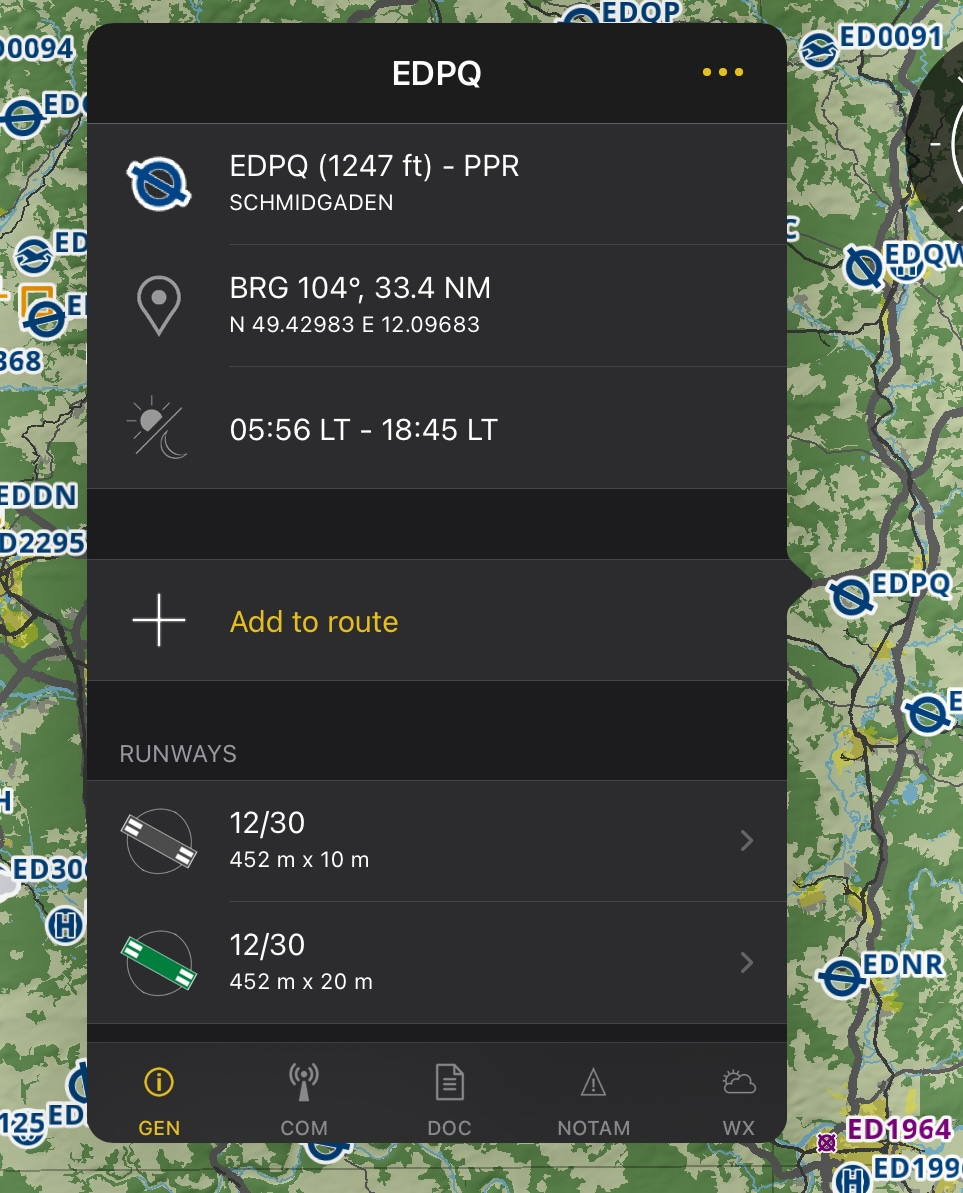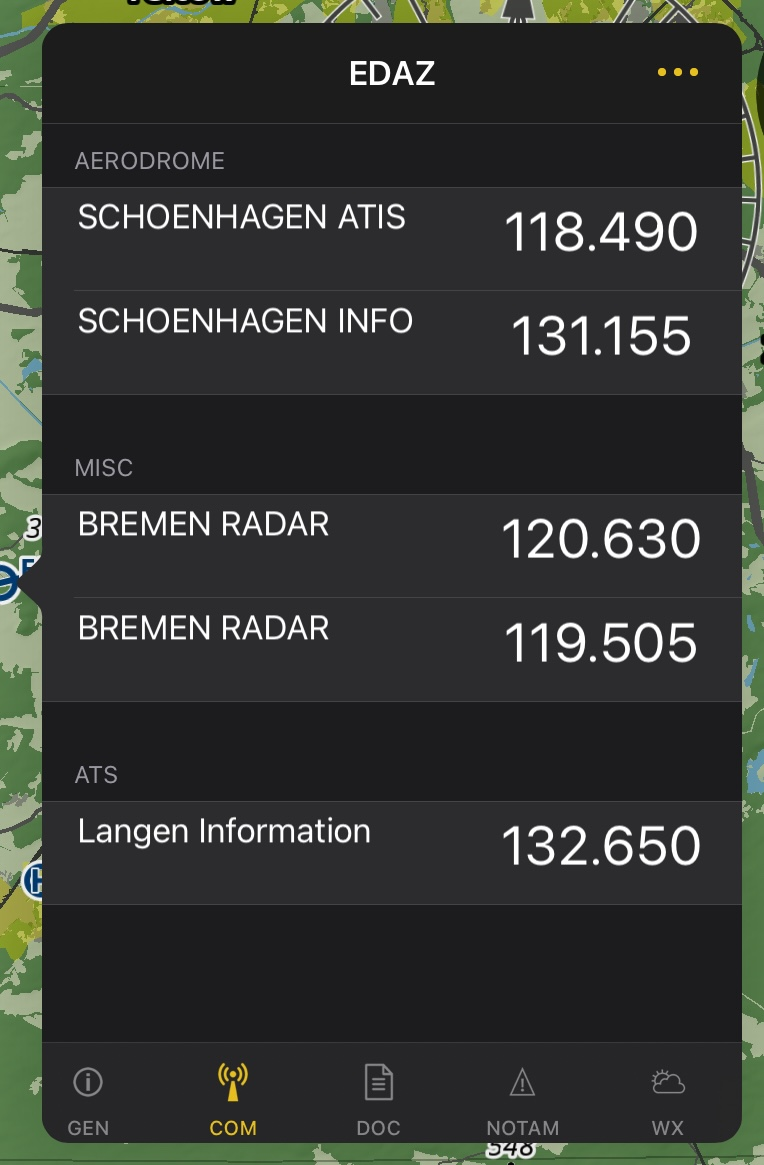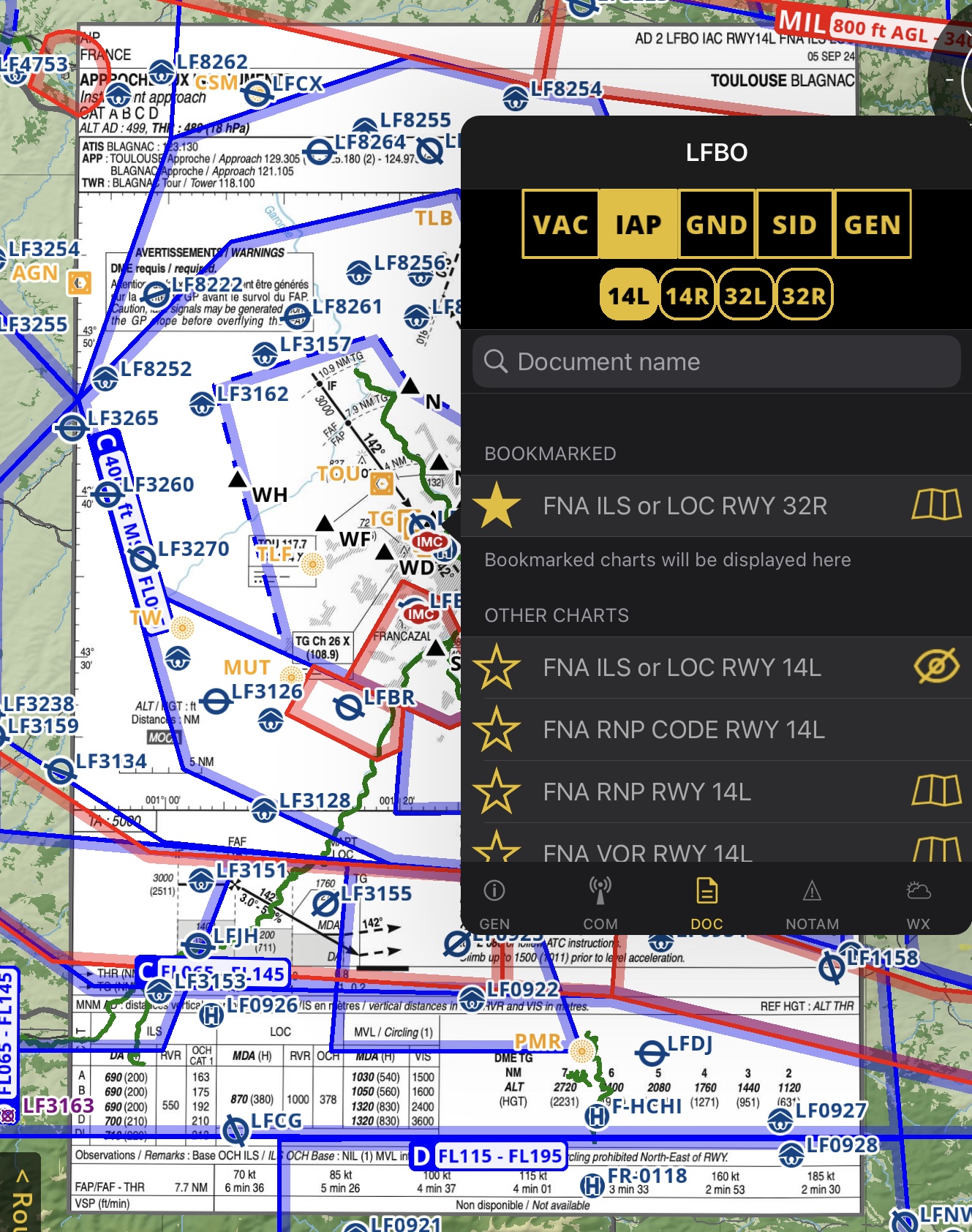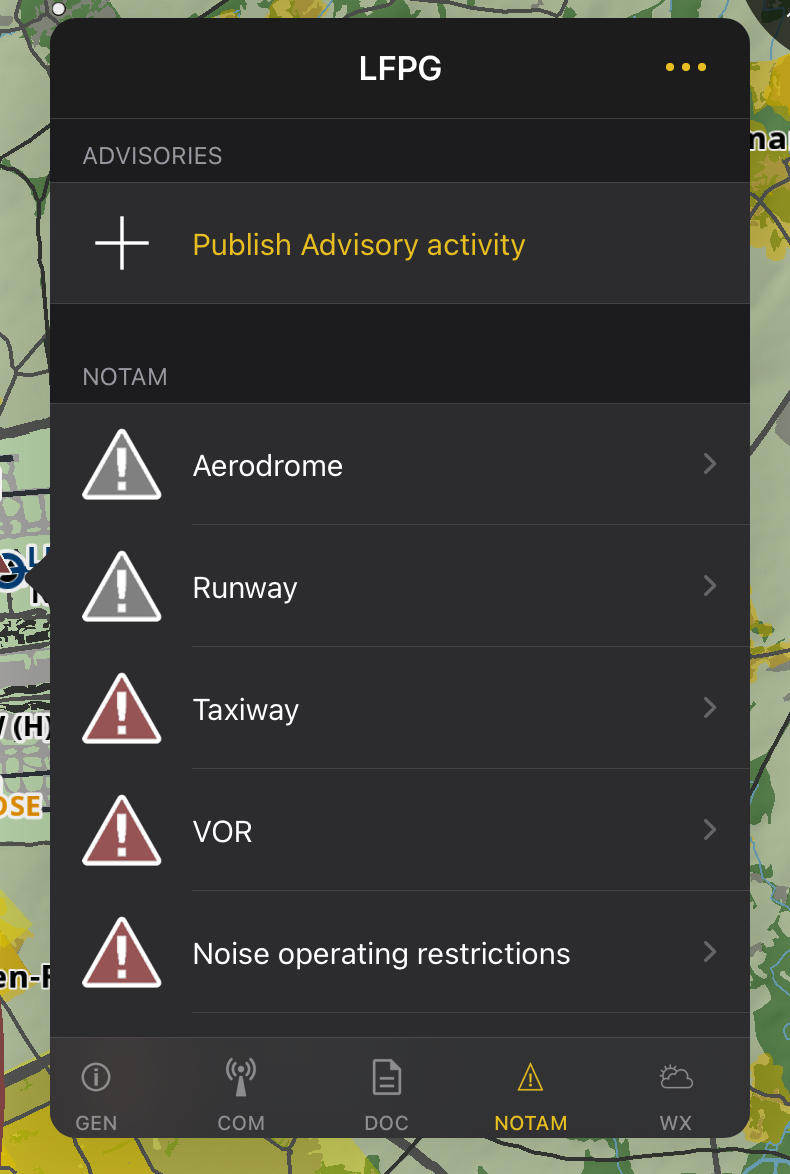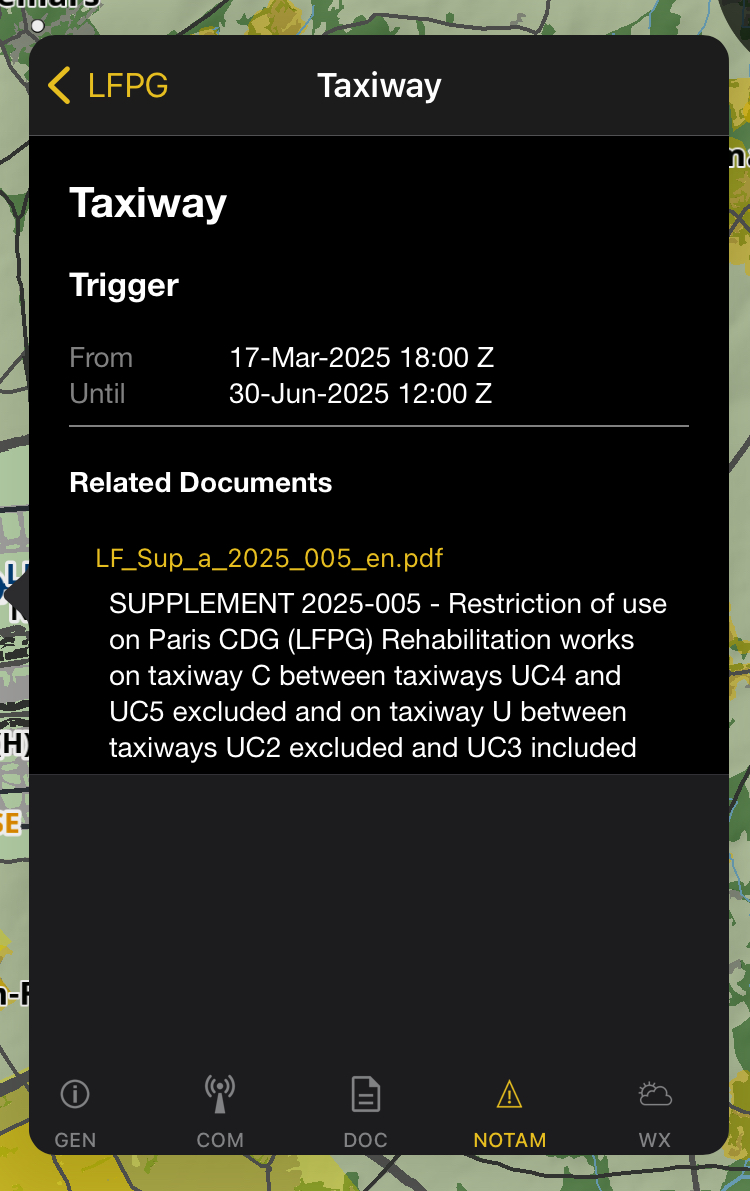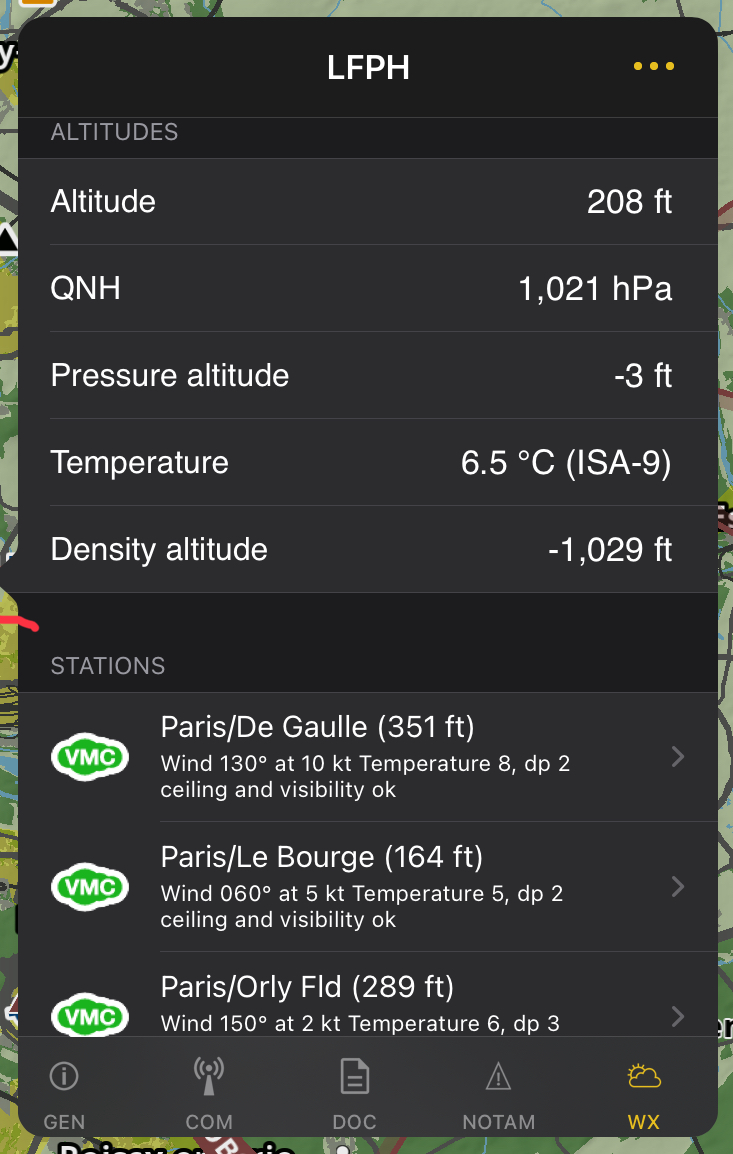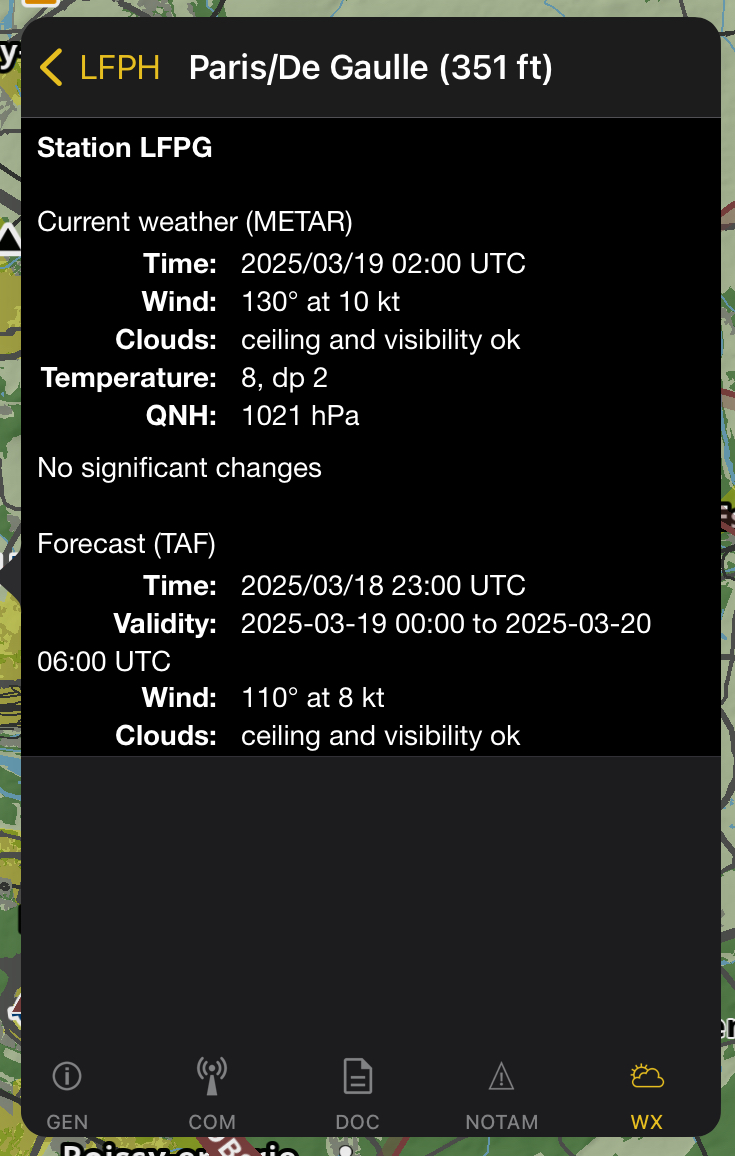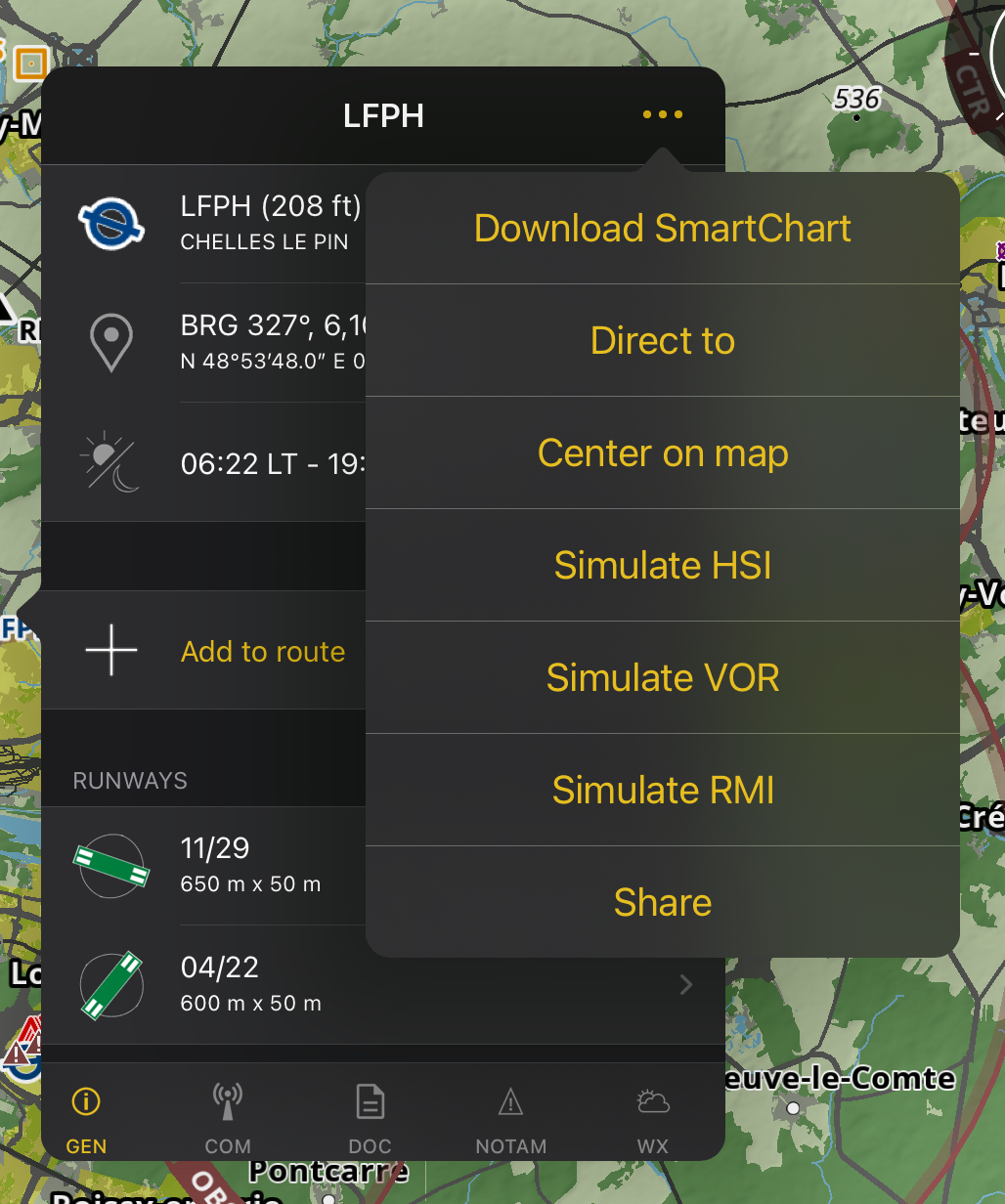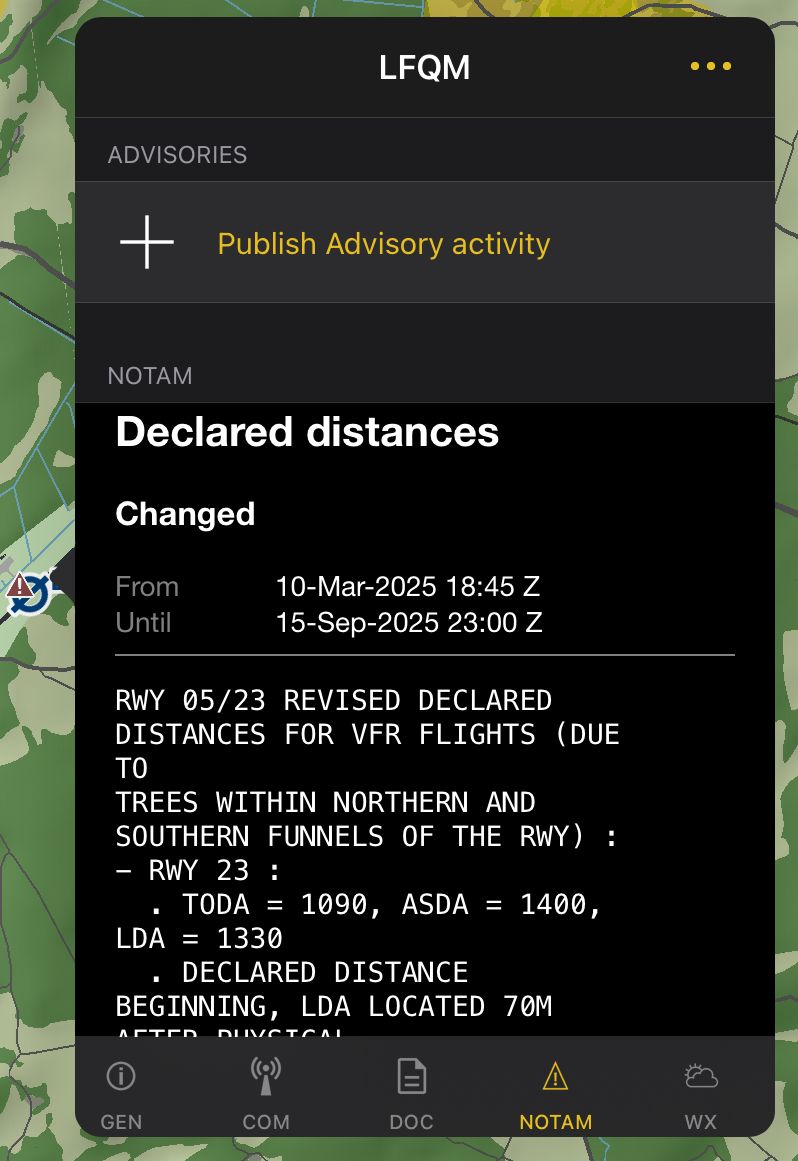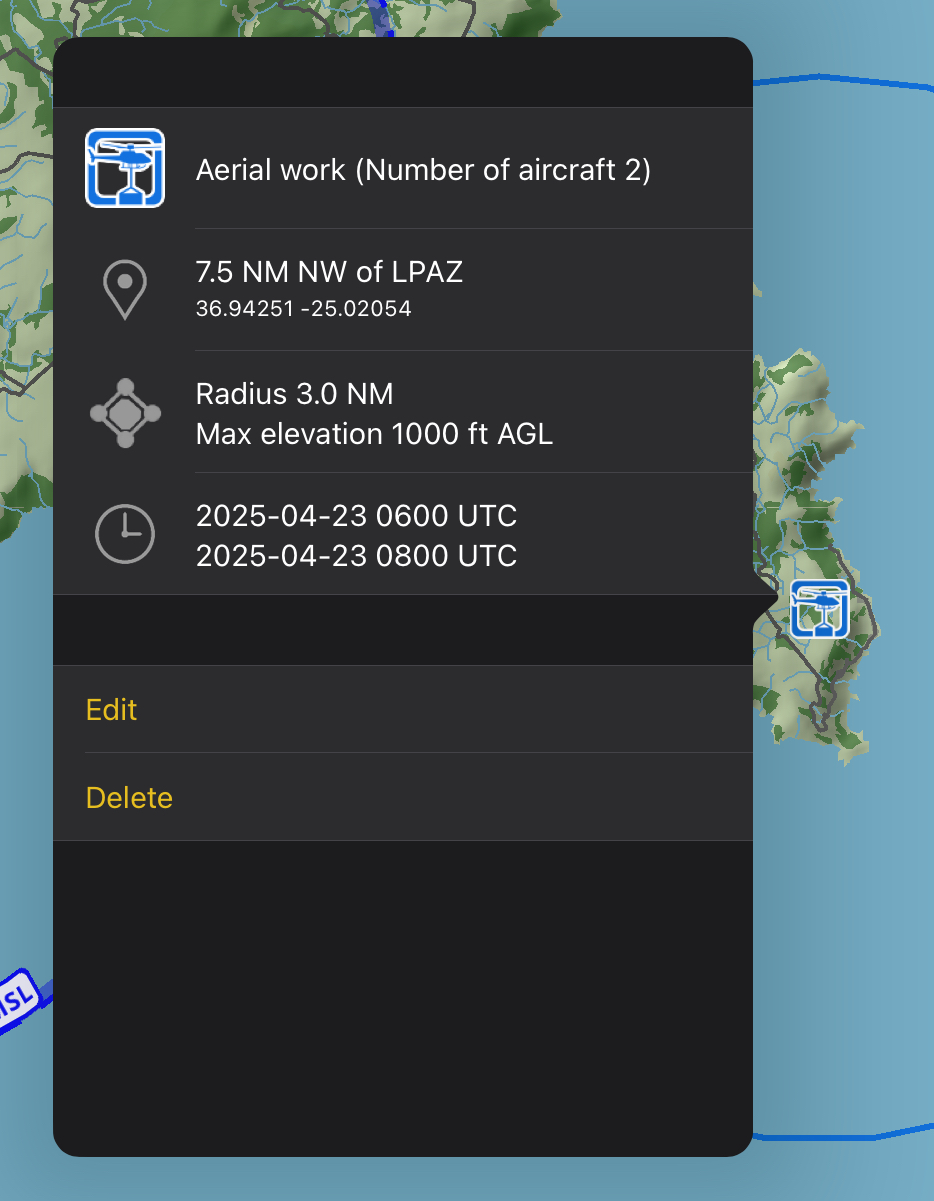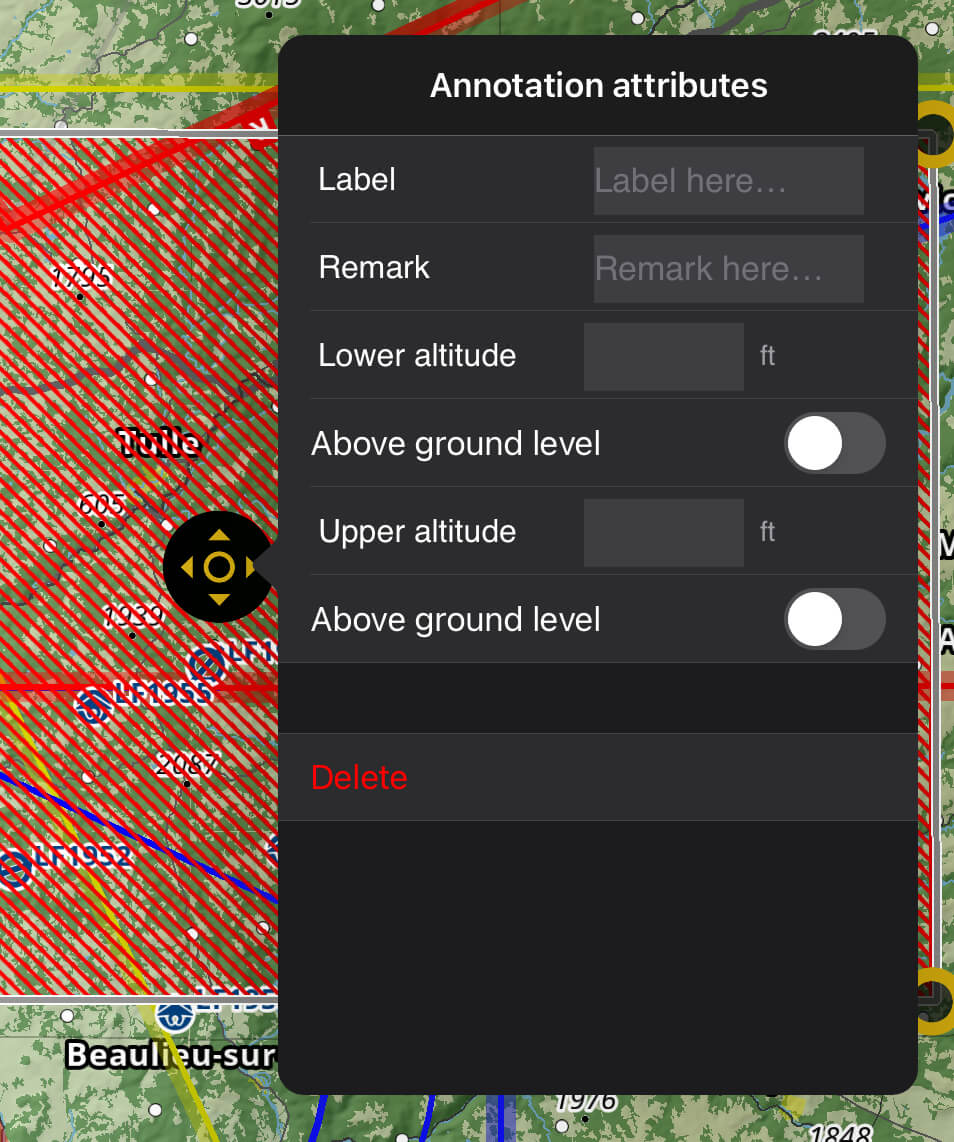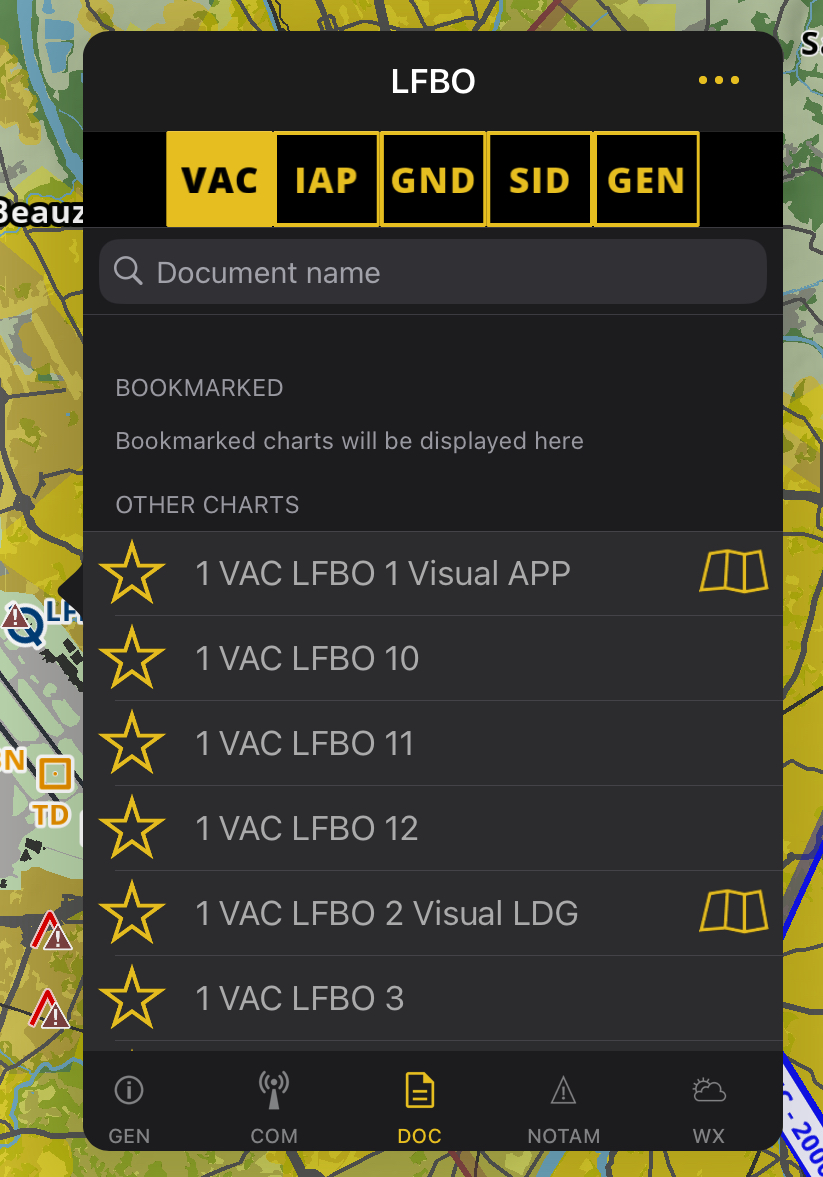Moving Map#
The Moving map is the heart of the application. It is where you spend most of the time interacting with Air Navigation Pro. It displays the necessary information to easily and safely plan your flight and navigate. Once you allow the application to access the device’s GPS, your location is shown on the map.
On the Moving Map you can see the following:
SmartChart (Terrain, cities, roads, landmarks, rivers, lakes)
You can also see other aircrafts when your mobile device is connected to the Internet, to an ADS-B or FLARM Module.
Aeronautical Data#
Airspaces#
Our extensive aeronautical database, included in any subscription and updated every 28 days following the AIRAC cycle, offers more than 65,000 airspaces of different classes, covering the entire world. You can install and update it in Configuration > Manage Data and Products. We recommend enabling automatic updates to ensure you always fly with the latest aeronautical information.
Tapping any point on the map will display a popover with detailed airspace information for that area.
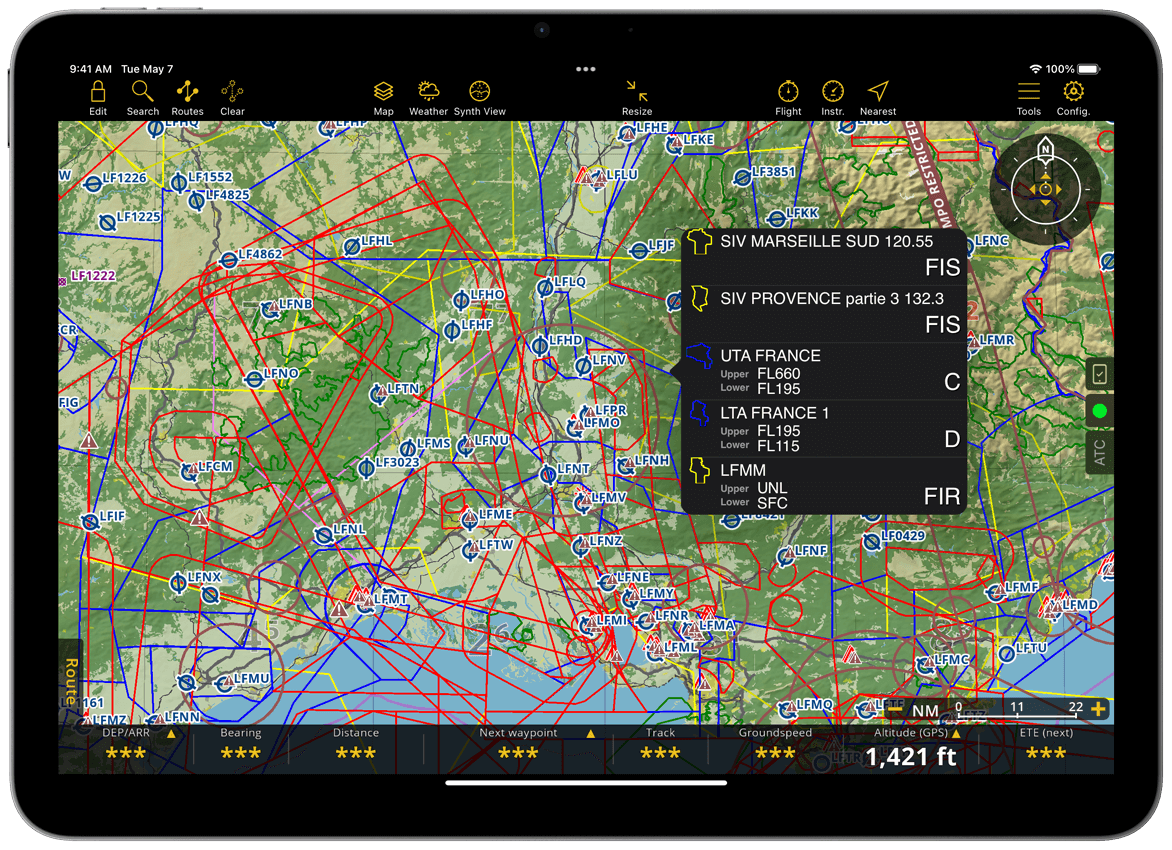
Airspaces have different colors based on their class. Below is the color legend to help you quickly identify each airspace class on the map:
Airspace Class |
Color |
A, B, Danger, Prohibited, Restricted, MATZ (MIL) |
Red |
C, D, E, F, CTR & Recreational |
Blue |
TMZ & Custom Airspaces |
Black |
TSA, TRA |
Pink |
Nature Reserve |
Green |
G, FIS & FIR |
Yellow |
Airspaces can be activated or deactivated via a NOTAM. Air Navigation Pro reflects these status changes with color. When inactive, the airspace will be shown in gray. If an airspace will become active within the next 24 hours, it will appear in its original color but with reduced opacity. Once activated, it will be displayed in its full color.
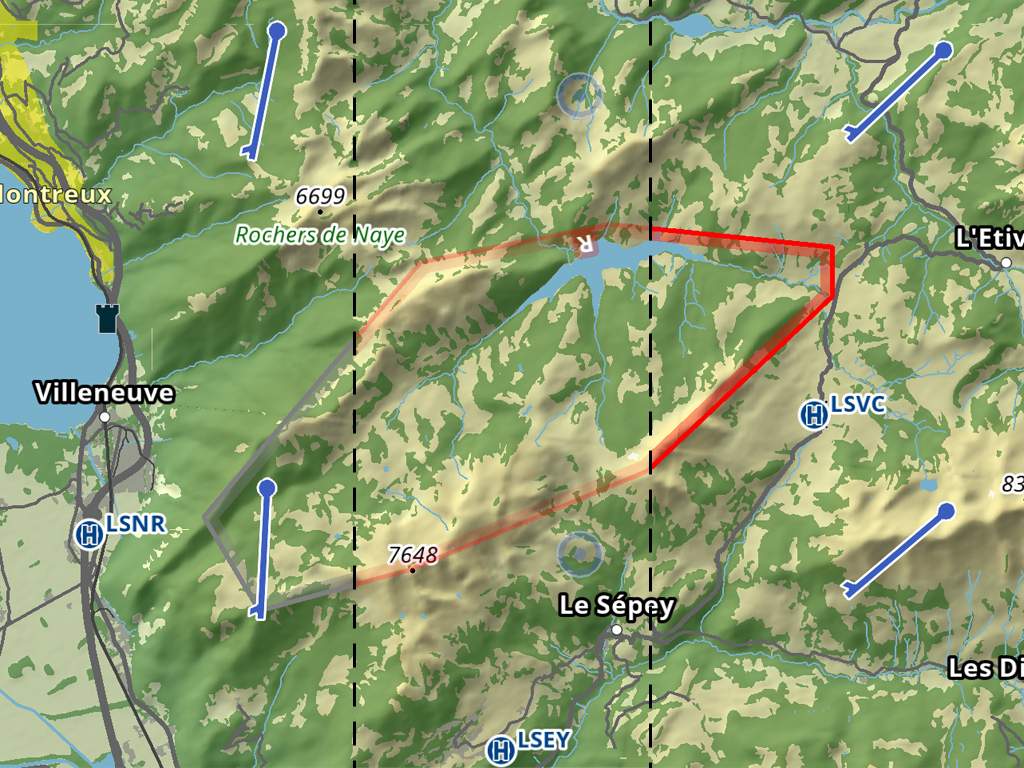
Hint
During Route Planning, you can set a departure time in the future and the map will show the activation status of airspaces for the time of your flight.
Following aeronautical chart design standards, airspaces are displayed with a label showing their class, floor and ceiling:
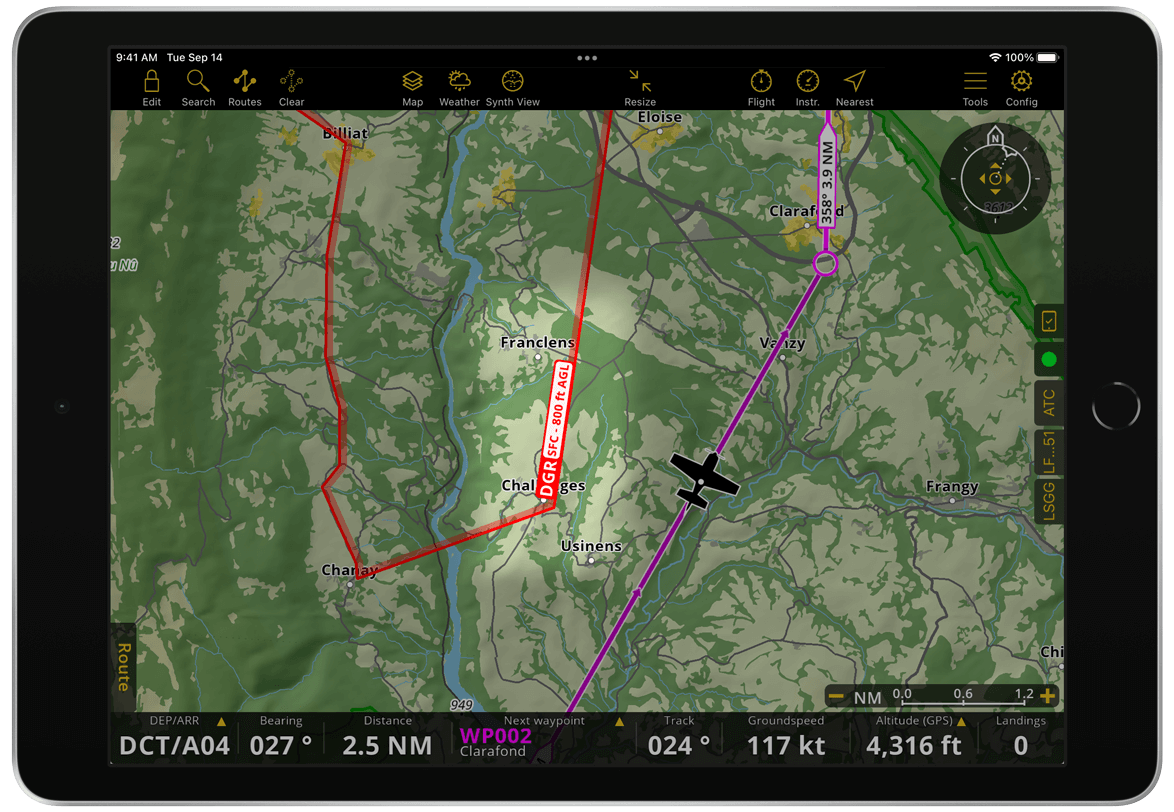
You can manage the display of airspaces in the Moving Map via Map Options > Airspaces. You can also display airspaces in the Profile View.
Waypoints#
Air Navigation Pro gives you access to over 210,000 waypoints worldwide, which are displayed on the map for easy route planning. You can easily Search for and add these waypoints to your route. Access to the waypoint database requires an active subscription. The database is updated every 28 days, in accordance with the AIRAC cycle. In the Map options menu, you can view all available waypoint types and customize which types of waypoints are displayed or hidden on the map.
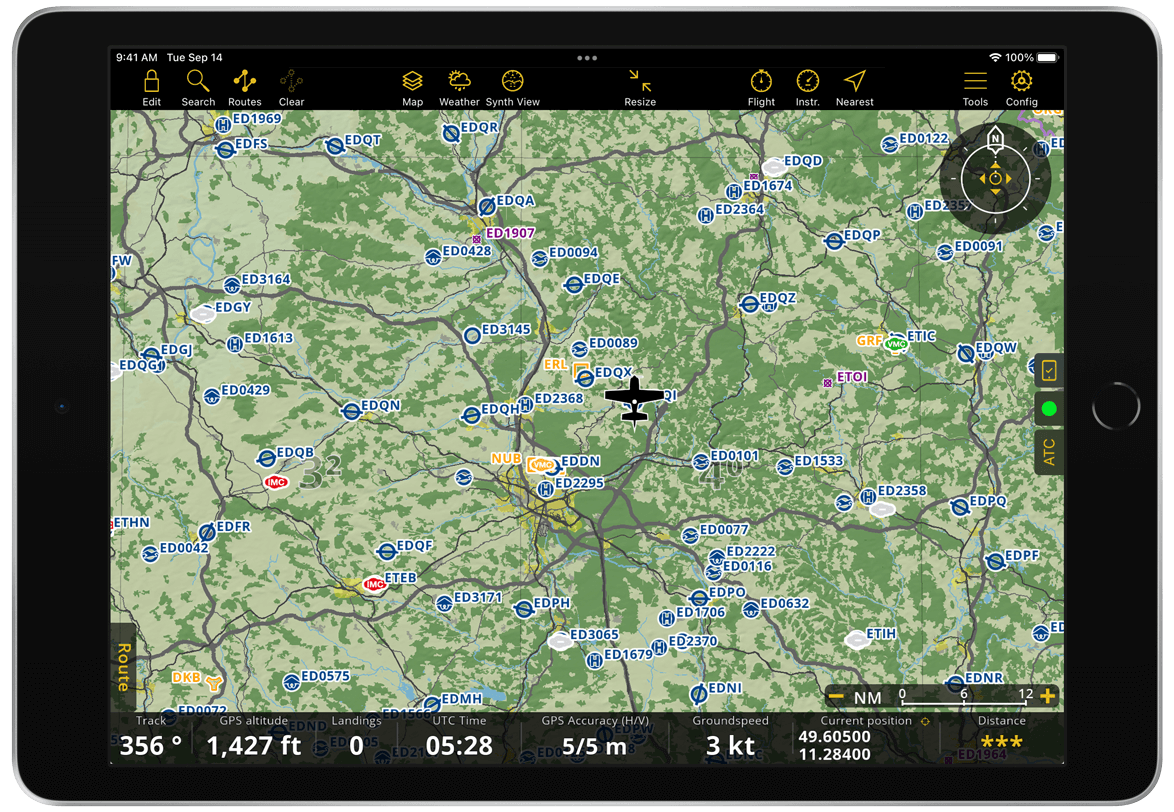
Waypoint popover#
Tapping on any waypoint on the map will display its details, including essential information and available actions. These are organized into the following tabs for easy reference: GEN (General), COM (Communication), DOC (Documentation), and WX (Weather).
GEN - The General tab displays the information about the selected waypoint, including:
Waypoint details - Displays the waypoint identifier (ICAO code), name, and airport elevation.
Waypoint location - Shows the bearing and distance from your current location, along with the waypoint’s geographic coordinates.
Sunset and Sunrise time - Provides the local times for sunrise and sunset at the selected waypoint.
Frequency (optional) – shows the radio frequency or channel used by the navaid to transmit signals for aircraft navigation.
Add to route button - Allows you to easily add the selected waypoint to your route.
Runways - Lists the available runways at the selected waypoint. Tapping on any runway will display additional details specific to that runway. If the waypoint is part of your route, a procedure selector will also appear in the runway information window.
Radionavigation beacons - At the bottom of the General tab, a list of radio navigation beacons (if available) is displayed. These beacons are VOR-type navaids within a 40 NM radius of the selected waypoint. Tapping on any beacon will provide additional information and available actions related to that beacon.
COM - The Communication tab shows a list of radio frequencies associated with the selected waypoint.
DOC - In the Document tab, you can install related products on demand if your account includes an approach chart for the selected waypoint. Once installed, all documents and charts will appear in this tab, organized by category.
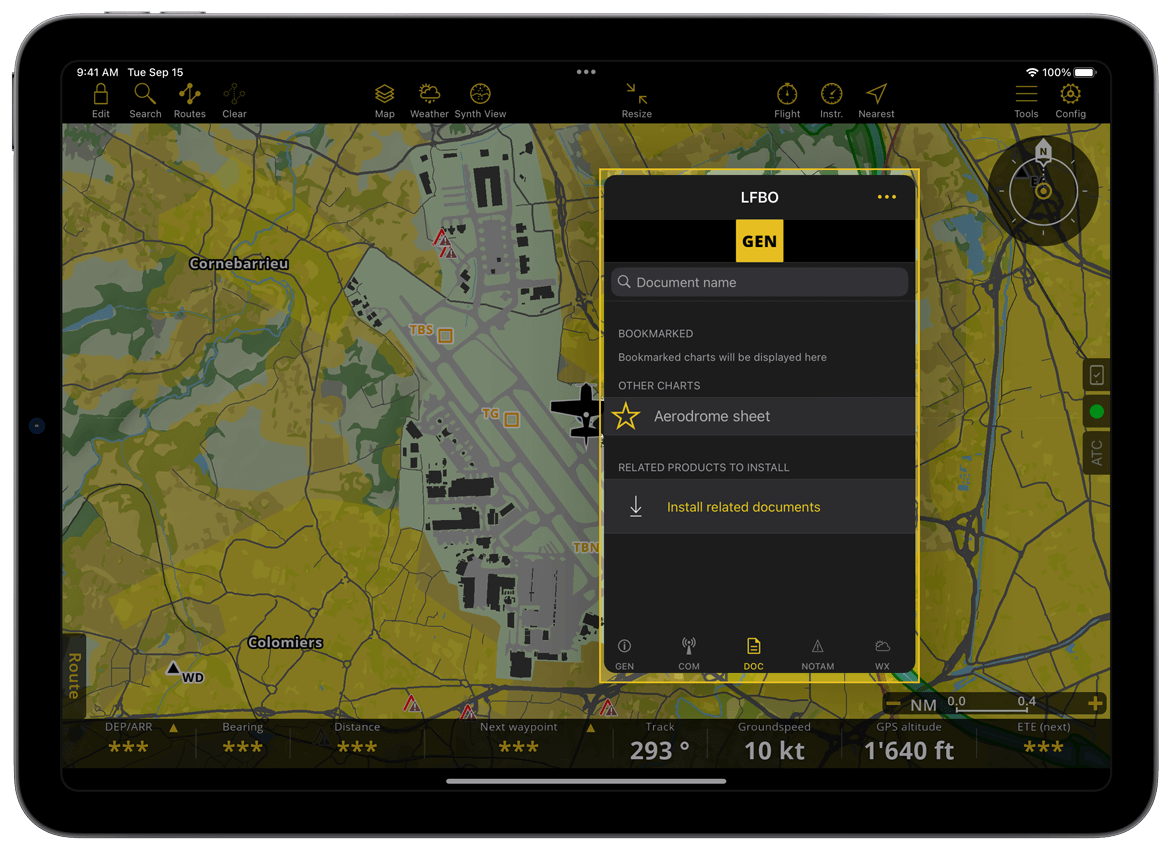
You can browse documents in each category or use the search feature for quick access. Each document has a ![]() icon next to it, and some may also display a
icon next to it, and some may also display a ![]() icon. Tapping the
icon. Tapping the ![]() icon will easily display them on the moving map while keeping the popover open. On phones, a toast message will confirm the chart is displayed. Now, the
icon will easily display them on the moving map while keeping the popover open. On phones, a toast message will confirm the chart is displayed. Now, the ![]() icon has been replaced by
icon has been replaced by ![]() .
.
You can bookmark any document from different categories as a favorite by tapping the ![]() icon. It will be saved in the Bookmarked section, which appears in every category and subcategory.
icon. It will be saved in the Bookmarked section, which appears in every category and subcategory.
NOTAM - In the NOTAM tab, you can publish advisory activies at the same location as the selected waypoint. This tab also displays a list of active and upcoming NOTAMs related to the selected aerodrome. Tapping on a NOTAM will reveal its essential details.
WX - The Weather tab displays the selected waypoint’s altitude, atmospheric pressure, and temperature, along with a list of nearby weather stations. Tapping on a weather station will display its current and forecasted weather report.
More options are available in the waypoint popover, including downloading the SmartChart for the selected waypoint for offline use, directing a route from your location to the selected waypoint, centering the waypoint on the map, simulate instrument, and sharing the waypoint in GPX format or via a Google Maps link. Simply tap the ![]() to access these options.
to access these options.
Weather stations#
Air Navigation Pro displays on the map reliable weather stations that are regularly updated. Tapping on the weather icon displays the weather information.
METAR/TAF stations have different coloured cloud icons which are to let you know about the flying condition: - Green with “VMC” - VMC - Visual Meteorological Conditions (VFR allowed) - Amber with “VMC” - Marginal VMC (Close to the limit for a VFR flight) - Red with “IMC” - Instrument Meteorological Conditions (Only IFR flights) - Black with “TAF” - No METAR but has TAF data - Grey with “-” - No data/network available or loading in progress
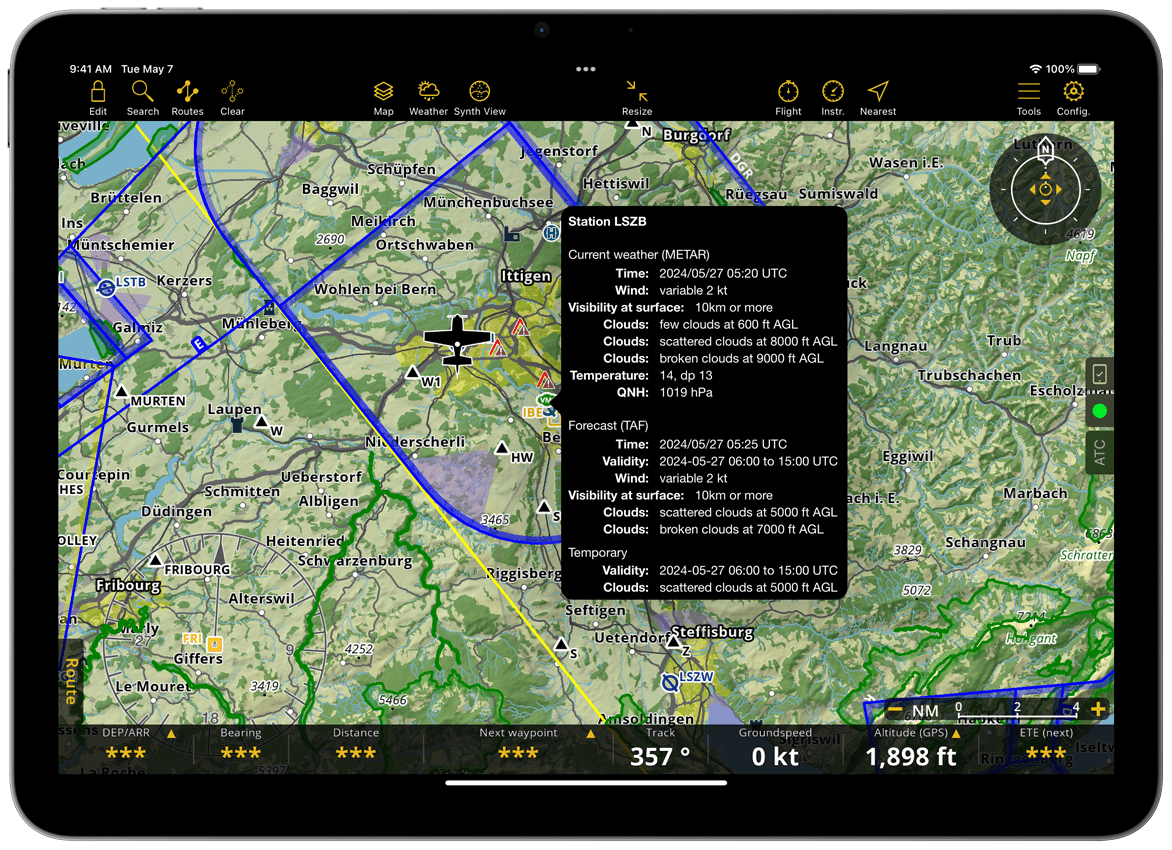
Air Navigation Pro reads the METAR and TAF and shows them in a user-friendly readable format. You can see the raw METAR/TAF by enabling the option “Raw METAR/TAF” under Configuration > Settings > MISC.
NOTAM#
Air Navigation Pro provides NOTAM information. This feature comes with any Subscription plans. NOTAMS are continuously updated when you are online. NOTAM that are active are highlighted in brown.
Not all NOTAM are displayed on the map: Air Navigation Pro filters out the least relevant ones to display only the most pertinent information. All NOTAM are still available when creating a preflight information briefing (see NOTAM).
Air Navigation Pro also hides NOTAM which will be applicable in a long time. You can change the activation period in Map Options > NOTAM.
You can tap on any NOTAM to obtain detailed information. Some NOTAM also relate to documents that may be downloaded and viewed directly from Air Navigation Pro, for example SUP.
NOTAM can also be shown/hide on the Profile View.
Types of NOTAM#
With their exact shape#
When Air Navigation Pro knows the exact shape of the NOTAM, it will display it precisely on the map. When the geometry of the NOTAM cannot be determined, and if the radius is small enough, it is displayed as a circle centered on the NOTAM position.
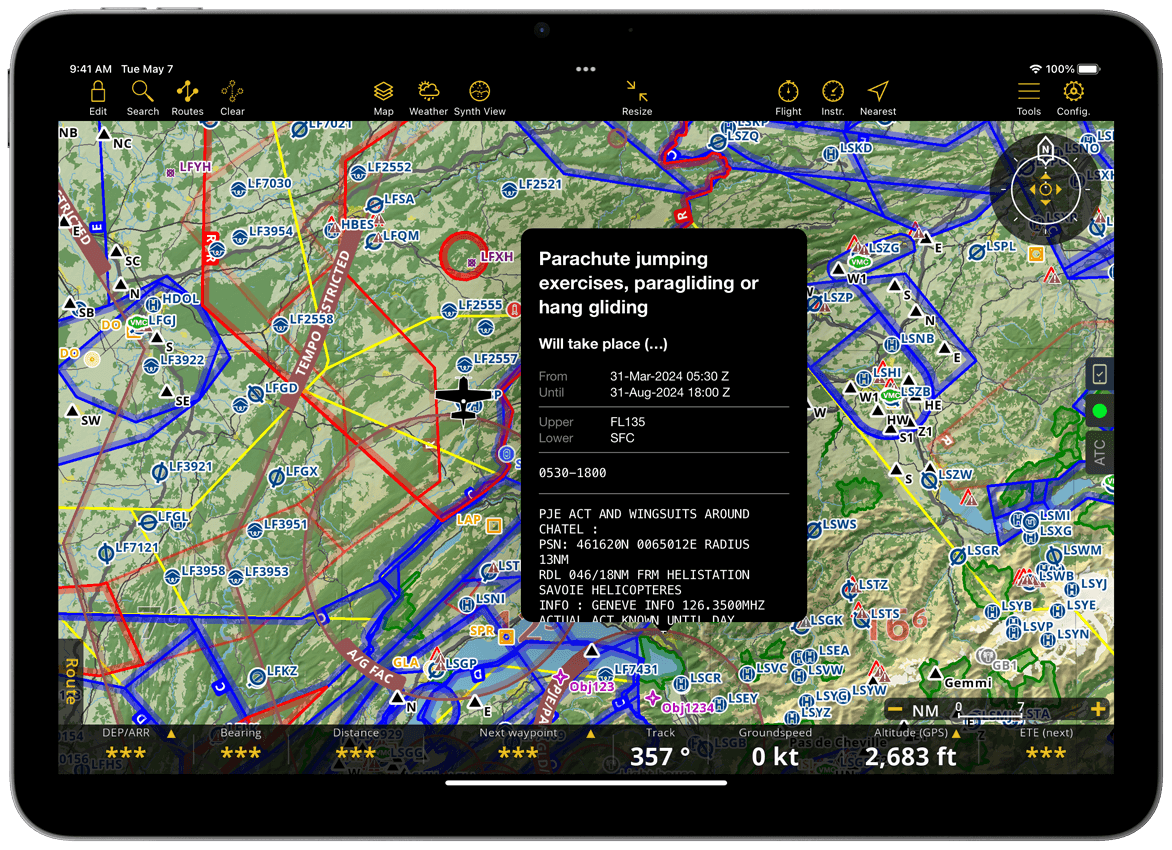
NOTAM belonging to an aerodrome#
This type of NOTAM is displayed using a triangular icon with an exclamation mark. For example, a NOTAM concerning an aerodrome’s runway will appear with its icon attached directly to the aerodrome’s icon. To view the NOTAM details, tap the waypoint and go to the NOTAM tab in the waypoint popover.
NOTAM belonging to an airspace#
If the NOTAM belongs to an airspace, Air Navigation Pro can sometimes detect it and display the NOTAM in the airspace, rather than displaying a circle all around the airspaces. Tap on the airspace to get more information about the NOTAM.
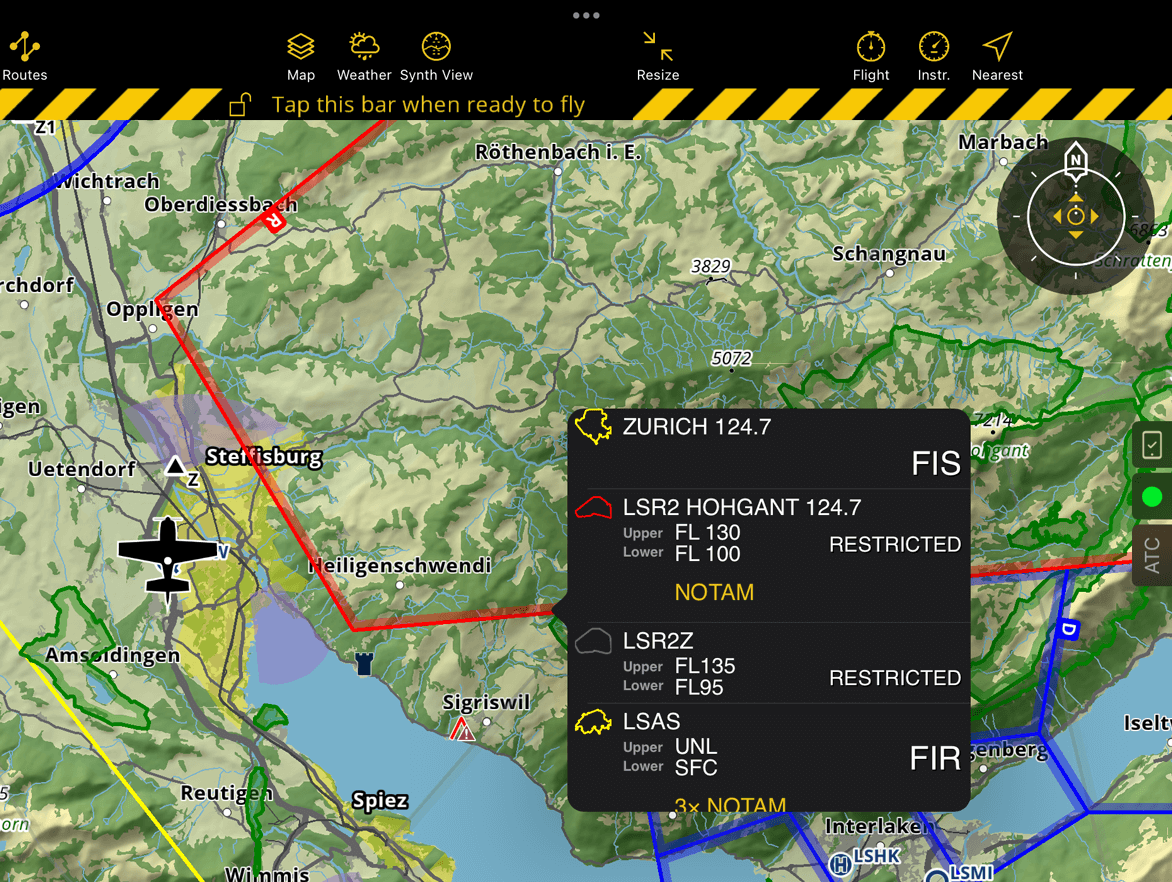
Note
NOTAM may affect the activation status of Restricted and Danger airspaces. While planning a flight, the app dynamically updates the airspace color to reflect its activation status based on your selected Departure Time. See more in Route Planning.
For obstacles#
NOTAM for obstacles are displayed as obstacles with a NOTAM icon.
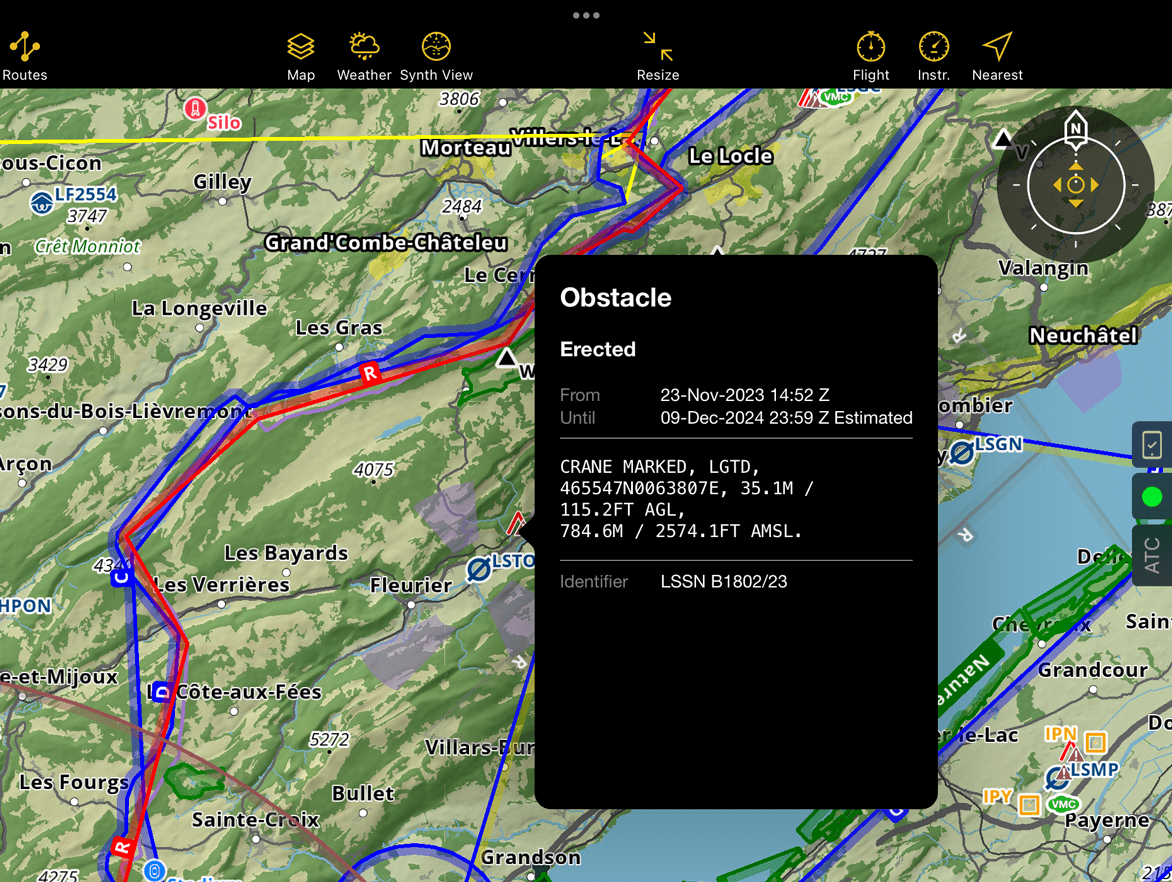
NOTAM that point to documents#
Some NOTAM contains documents and it is now possible to view or open them. It is attached inside the NOTAM popover.
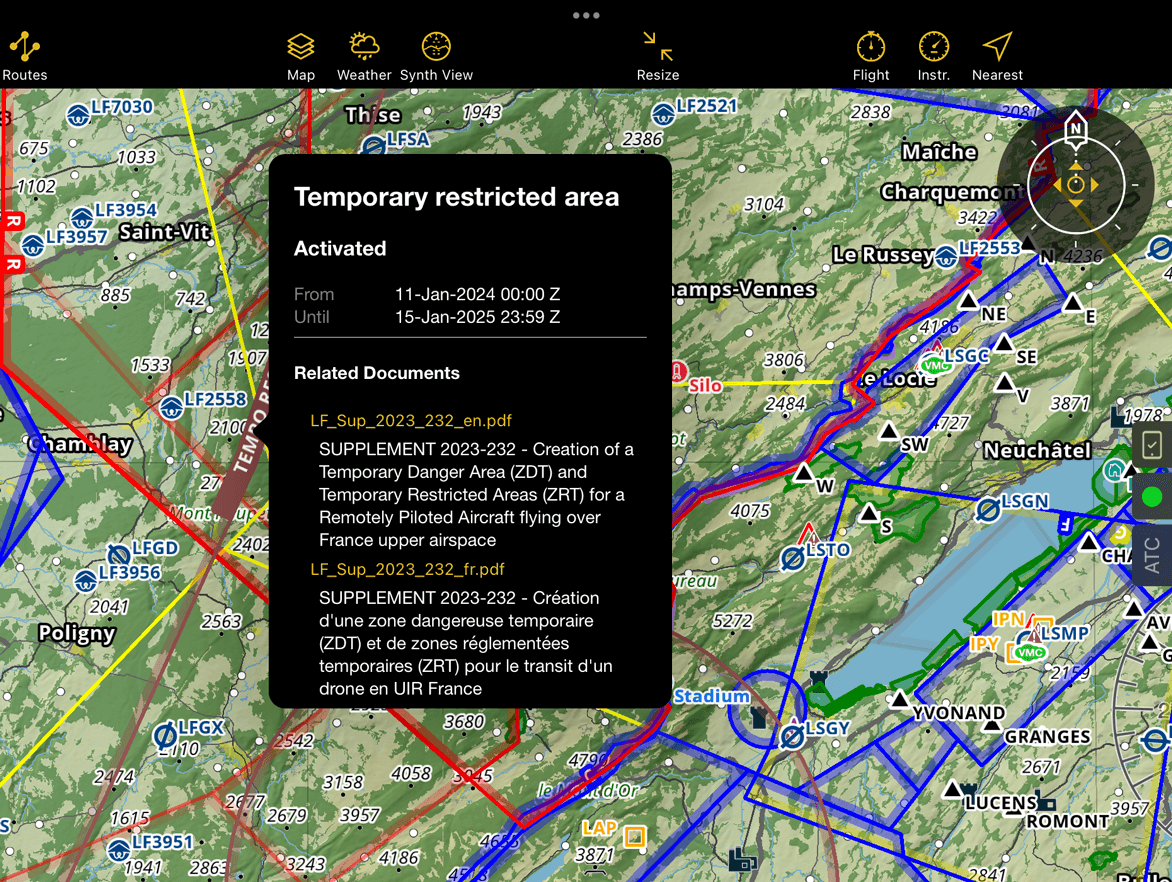
SNOWTAM & ASHTAM#
The application also support and displays SNOWTAM & ASHTAM on the map with their details.
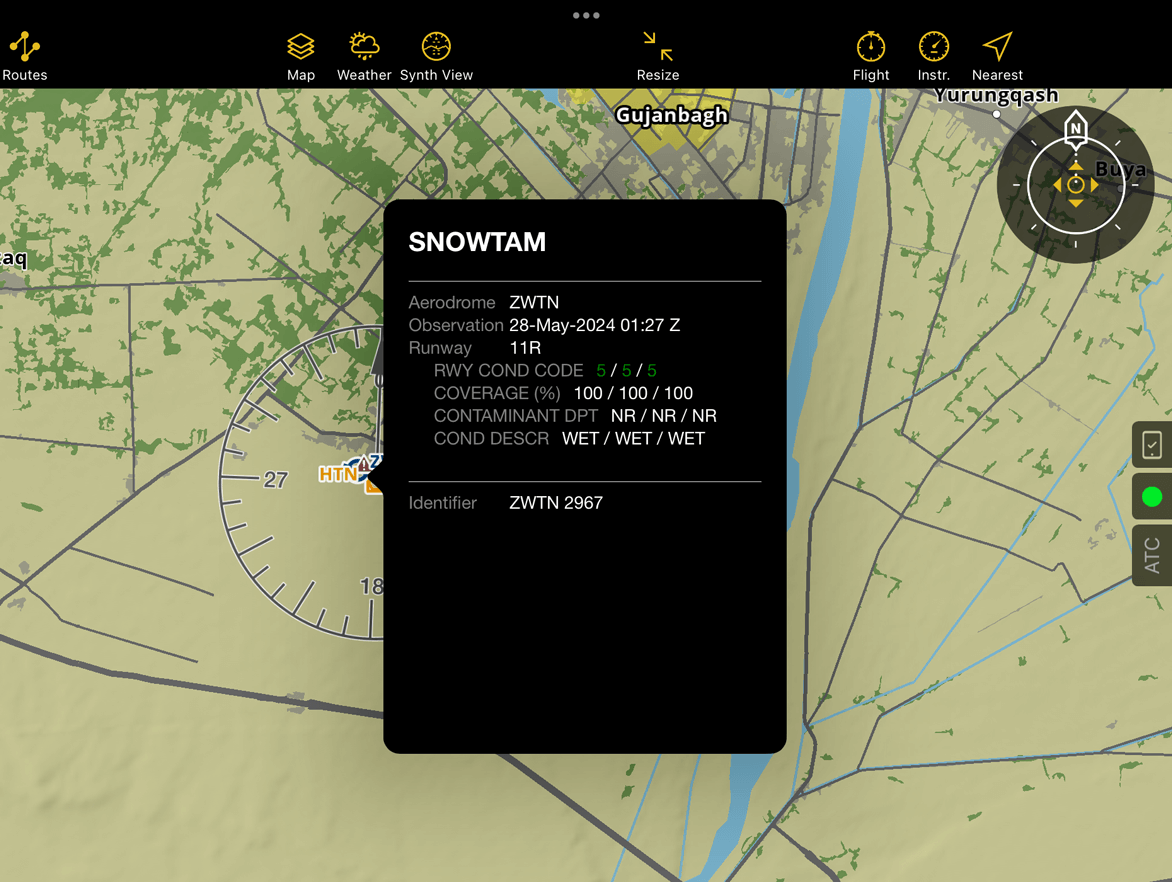
Obstacles#
We offer a wide-ranging obstacle database for selected countries as part of our Subscription plans. The database is updated weekly to ensure you have the latest obstacle information available for your flight. You can install the obstacles database from Manage Data and Products. The display of obstacles on the Moving Map can be managed in Map Options > Obstacles.
You can also display obstacles on the Profile View.
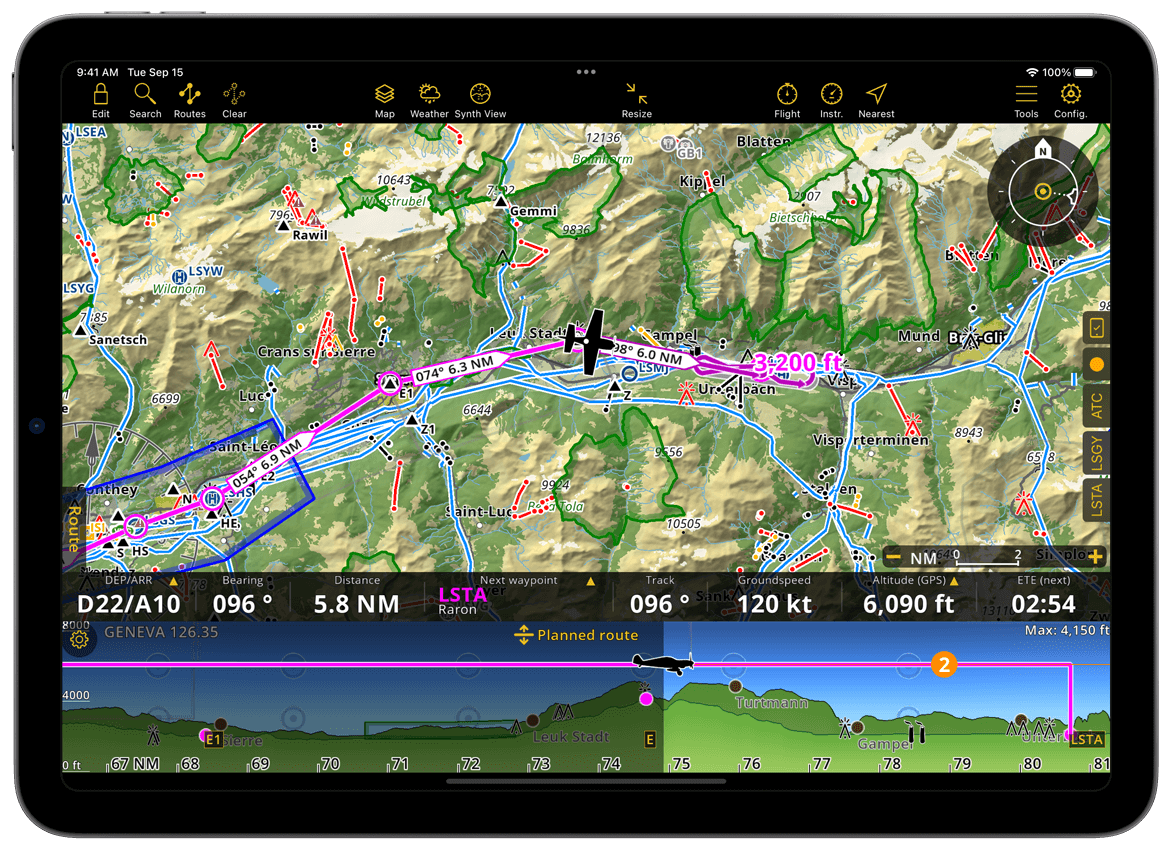
Types of obstacles#
Points#
Obstacle points are represented by icons. To avoid cluttering at lower zoom levels, only one icon will be displayed even if multiple obstacles are located in the same area. Zooming in will display more detailed information for each individual obstacle in that area.
Lines#
The app does not offer decluttering for lines, so obstacle lines are not visible at lower zoom levels. Once you zoom-in enough to allow a clean display, they will be displayed. For Norway, you can color power lines based on their height from ground in Map Options > Obstacles.
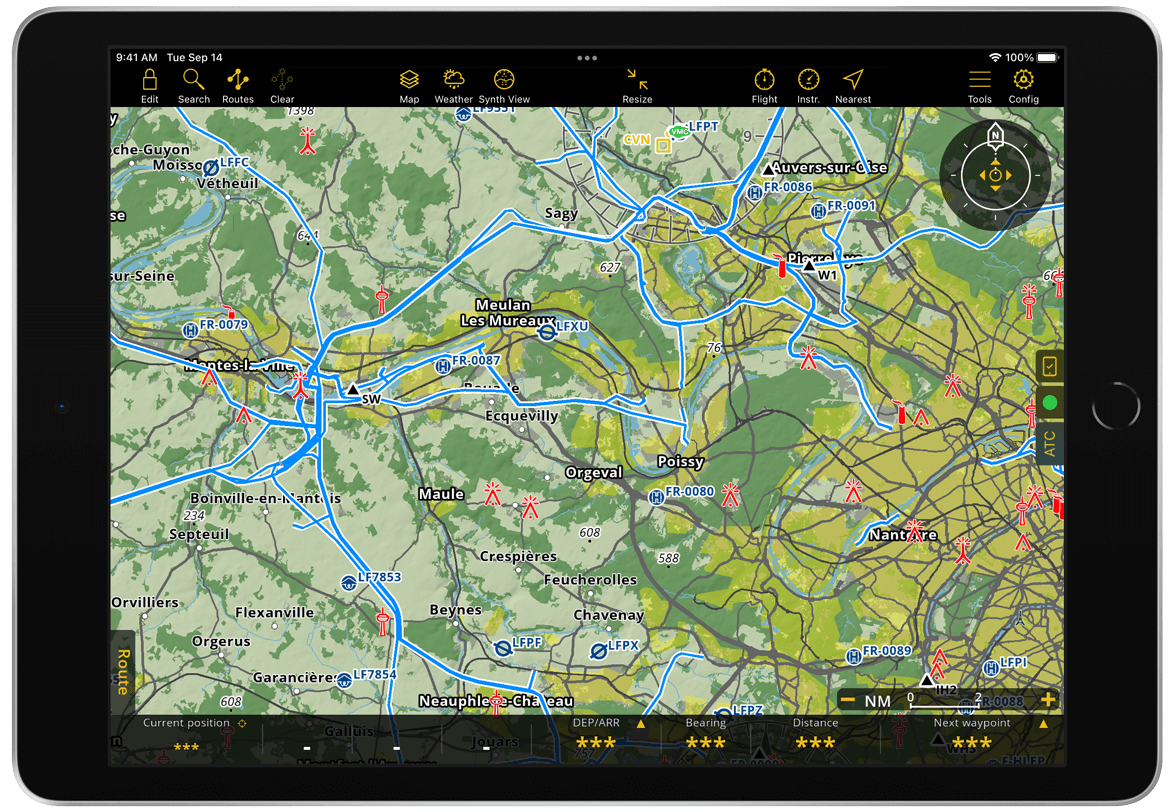
Colored power lines.
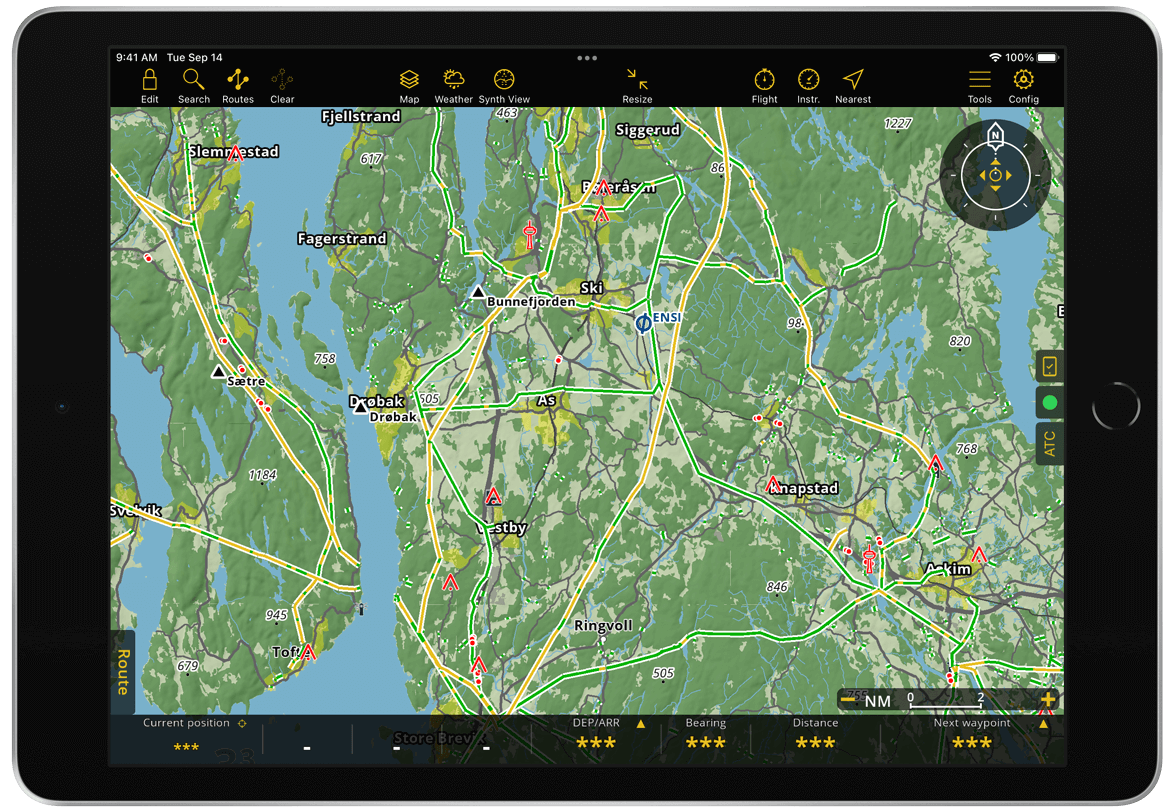
Tappable Obstacles#
To interact with obstacles on the map, first ensure you are zoomed in to the appropriate level. Once zoomed in, you can tap on individual obstacles to view more information. If multiple obstacles appear close together, tap the cluster and then select the specific obstacle you wish to view. A popover will appear, displaying detailed information about the selected obstacle.
Clustered Obstacles upon tapped.
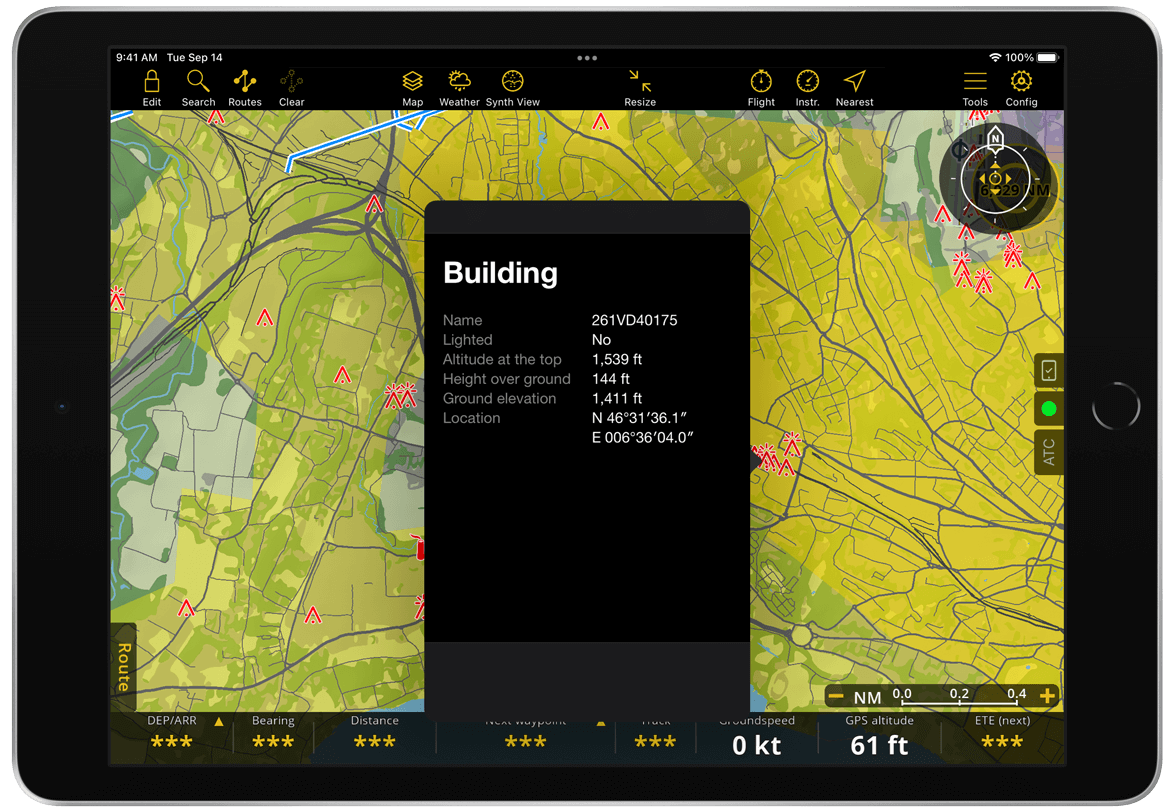
Selected Obstacle displayed popover with details.
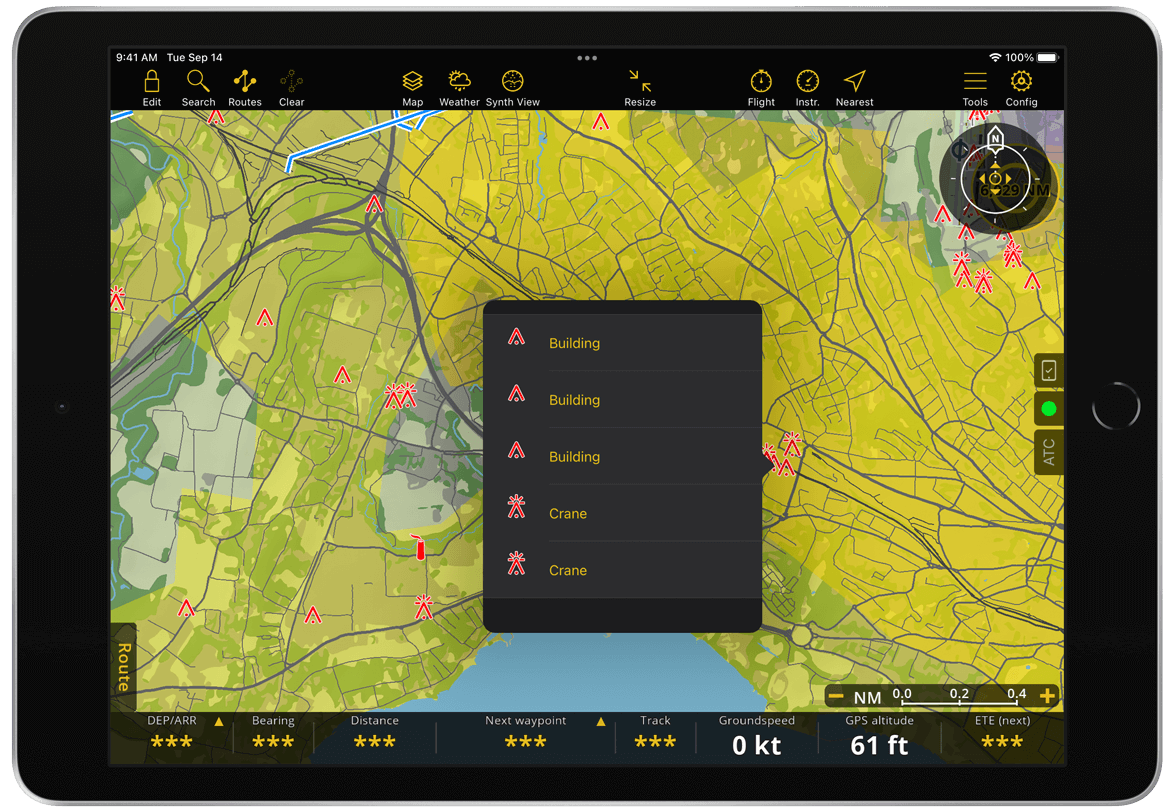
Surfaces#
Obstacle surfaces are not very common. They are displayed on the map as areas with a red border and clearly labeled as Obst. An example of an obstacle surface is an area with several wind turbines, which is displayed as a single marked area instead of identifying each turbine as obstacle individually.
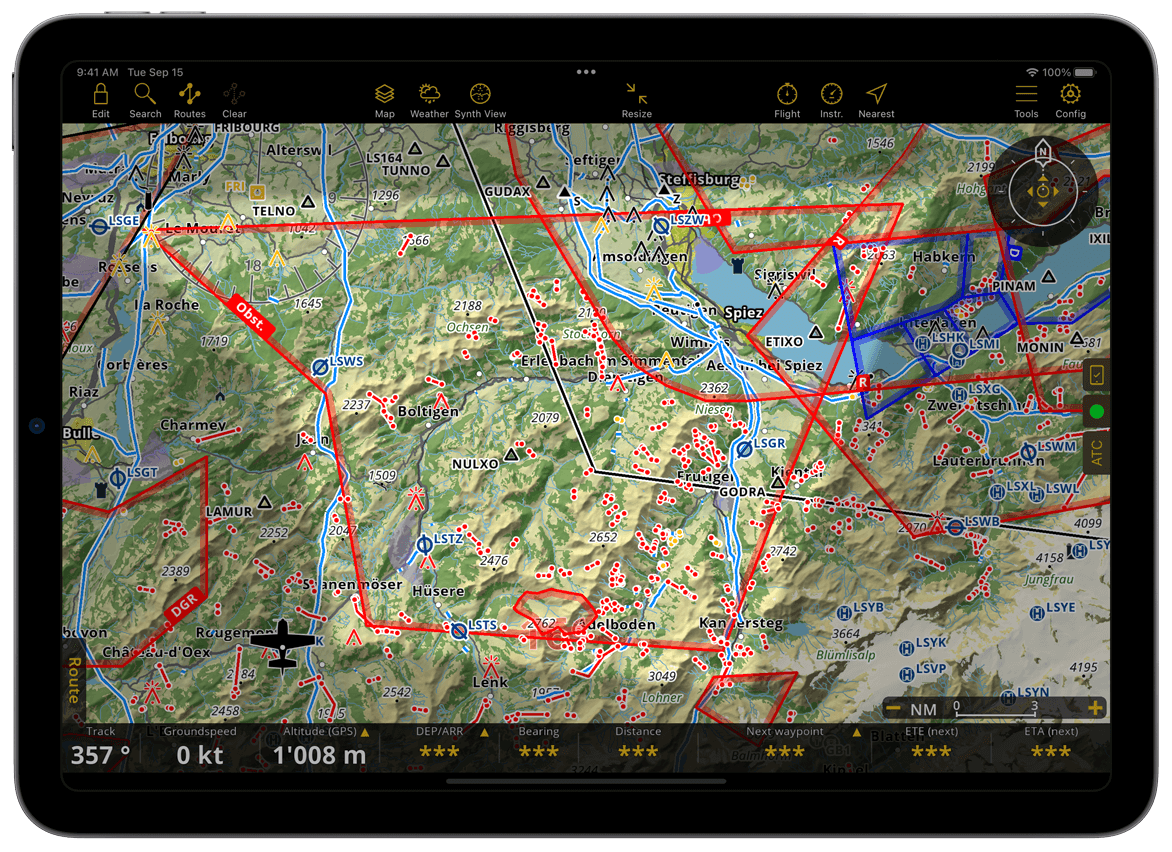
User Data#
User Waypoints#
In addition to the ref:waypoints provided from the worldwide aeronautical database, Air Navigation Pro offers the possibility to create and import your own waypoints, referred as ‘User waypoints’. You can easily manage, back up, and restore these waypoints through the Tools menu.
Create via the Moving Map#
Press and hold on the map at the location where you want to create the user waypoint.
Tap the Create user waypoint button.
The app will automatically populate the waypoint details, but you can modify them by tapping the fields you wish to edit.
Tap Done in the top right corner to save.
The user waypoint will now be displayed at the location you selected on the map.
Create via Tools#
Navigate to Tools > User waypoints.
Tap the + Add a new waypoint button.
The app will automatically populate the details based on your current location, but you can edit any field by tapping on it.
Once finished, tap User Waypoints (tablet version) or Back (mobile version) to save your waypoint.
The newly created user waypoint will appear at the map location you specified.
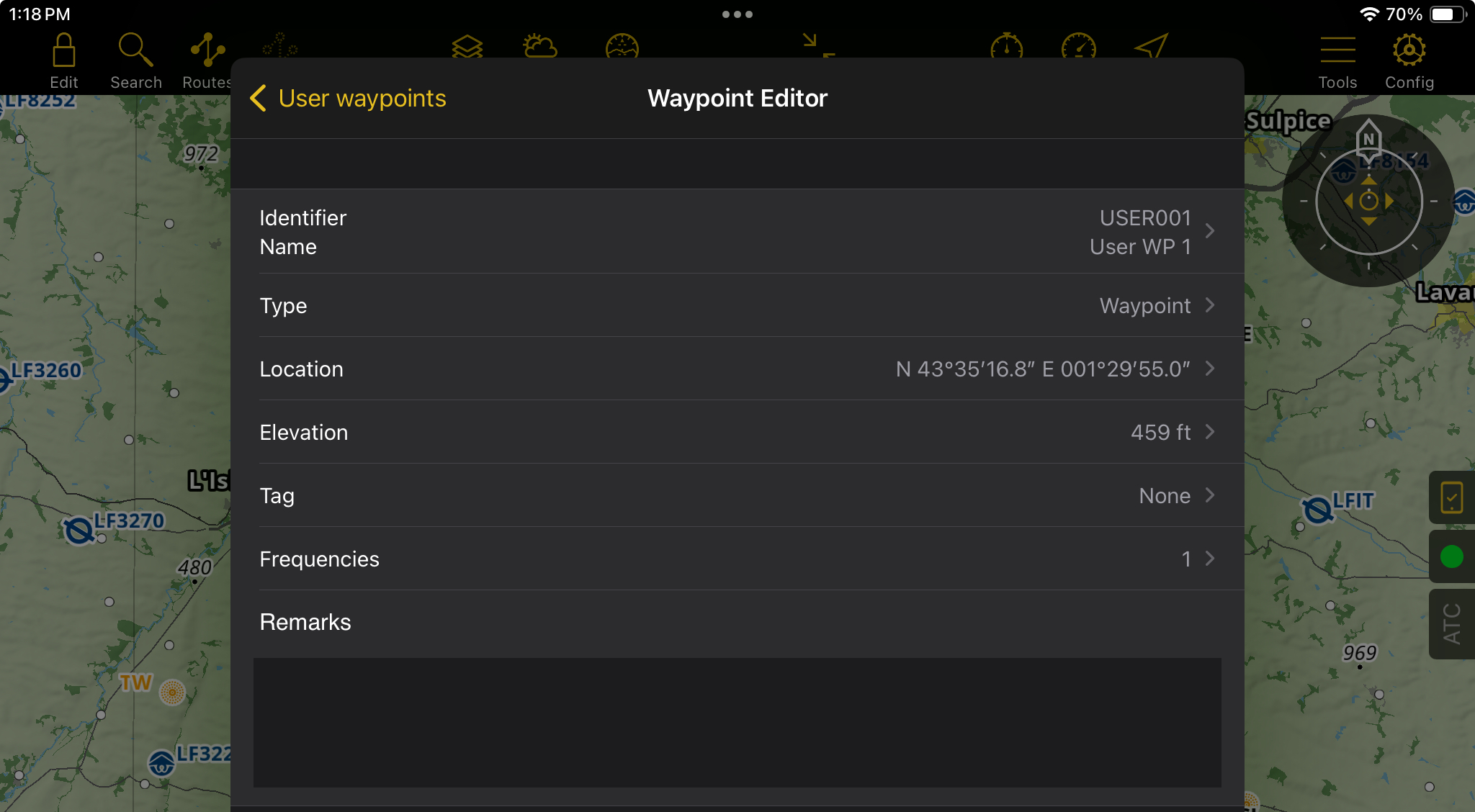
Note
Except for the waypoint name, tag, and remarks, all other fields are mandatory and cannot be left blank.
Create via URL#
For companies wanting to send waypoints to their pilots, it is possible to create a weblink, send it via email or SMS, and when the pilot click on it, a waypoint or a route is be added in Air Navigation Pro. It is available only on iOS.
The following part is very technical and it explains how to write the weblink. Sending it to the pilot is up to you: use your email, notes, safari or messaging app. Warning: It is not working on Gmail, Chrome.
Supported actions:
Direct-to
Import waypoints to user database
Create route
The URL looks something like this:
airnavpro://direct-to?coordinates=wgs84-decimal&location=46.875_7.234,0.0,WP1,Grass field
And once encoded:
airnavpro://direct-to?coordinates%3Dwgs84-decimal%26location%3D46.875_7.234%2C0.0%2CWP1%2CGrass%20field
It consists of:
URL scheme: airnavpro://
An action: direct-to
Coordinates format: coordinates=wgs84-decimal
waypoint(s): location=46.875_7.234,0.0,WP1,Grass field
Note
The query part of the URL has to be URL encoded in order to support special characters.
Waypoint format for any action can be defined with different values separated by a comma (,). Waypoints are separated by semicolons (;).
Waypoint values:
Coordinates
Waypoint name
Waypoint ID
Elevation (in meters)
Coordinate formats:
WGS84 in DD:MM:SS |
Irish grid without zone |
WGS84 in DD:MM.decimal |
Irish grid with zone |
WGS84 in DD.decimal |
NZ Grid 1949 |
Standard UTM |
NZ Grid 2000 |
UTM with bands |
Swissgrid (CH1903) |
UPS |
UK Grid without zone |
MGRS 100m |
UK Grid with zone |
MGRS 10m |
Swedish grid RT90 |
MGRS 1m |
Swedish grid SWERED99TM |
A waypoint must, at least, contain the coordinates information. The coordinates information may be composed of two values, in this case the coordinates must be linked with an underscore (_). For example, a waypoint description for a wgs84 decimal format: 46.875_7.234
Here is a full example with elevation, ID and name data: 46.875_7.234,0.0,WP1, Antenna
Direct-to#
Direct-to can be achieved by formatting an URL with the “direct-to” command. Only one waypoint can be specified and it has to be in the following format: location=waypoint
Here are some examples of direct-to URLs:
WGS84 decimal:
airnavpro://direct-to?coordinates=wgs84-decimal&location=46.875_7.234,0.0,WP1,Grass field
WGS84 degrees minutes seconds:
airnavpro://direct-to?coordinates=wgs84-ddmmss&location=N 12°34'56''_W 78°12'34'',0.0,WP1,Grass field
Swissgrid CH1903:
airnavpro://direct-to?coordinates=swiss&location=602030.68_191775.03,0.0,WP1,Zimmerwald
Import waypoints to user database#
A list of waypoints can be imported directly into the user database with a specially formatted URL with the “add-waypoints” command. A list of waypoints can be specified and it has to be in the following format: waypoints=point1;point2;point3
Here is an example of add-waypoints URLs:
airnavpro://add-waypoints?coordinates=wgs84-decimal&waypoints=46.123_6.543,125.0,WP1,Grass field;47.113_7.143,225.1,WP2,Forrest;45.153_6.643,1225.0,WP3,Antenna
Advisories#
They are published by other users to inform about special activities in the sky.
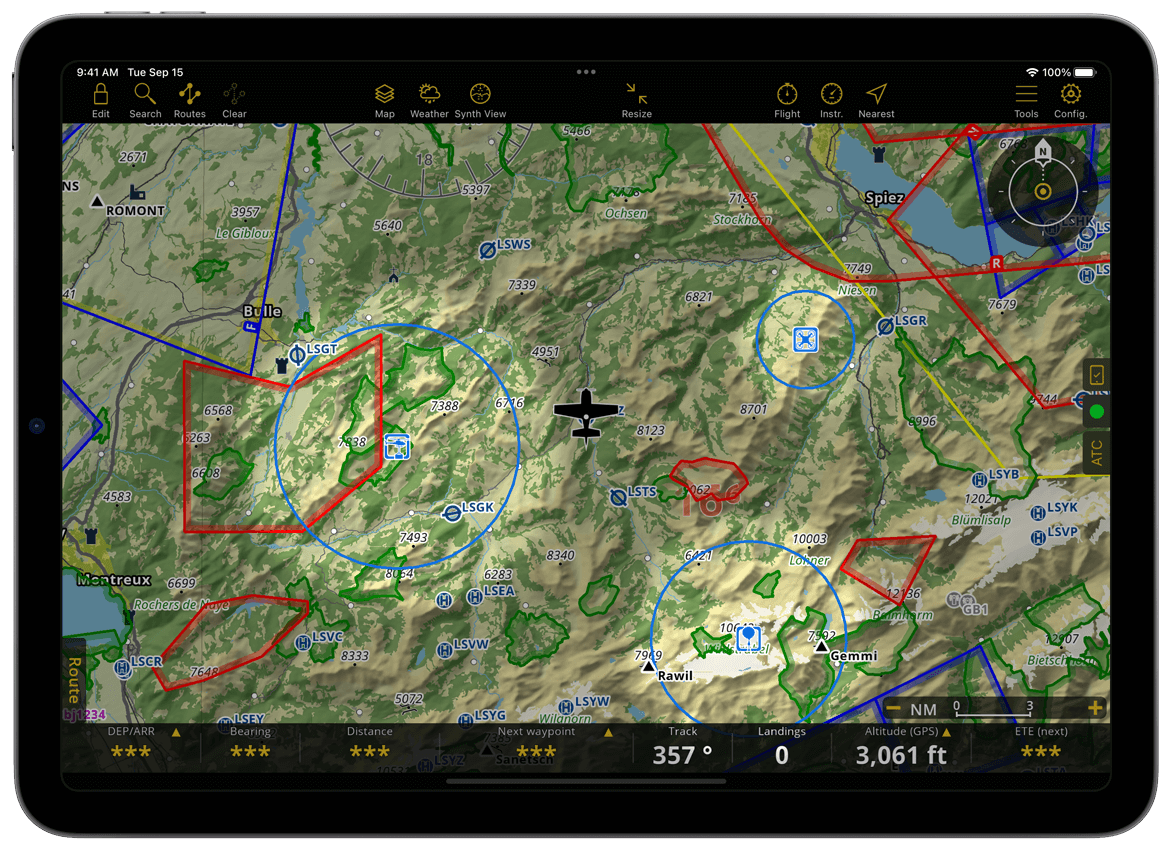
Air Navigation Pro offers you to see advisories published by other users and to publish your own.
Note
Air Navigation Manager customers can create and edit advisories from the web service.
Life cycle#
For advisories where the user is the author, they are displayed at all times up until they expire. While advisories that come from other users, they are displayed 12 hours before their start period and disappear as soon as they expire.
Publish Advisories#
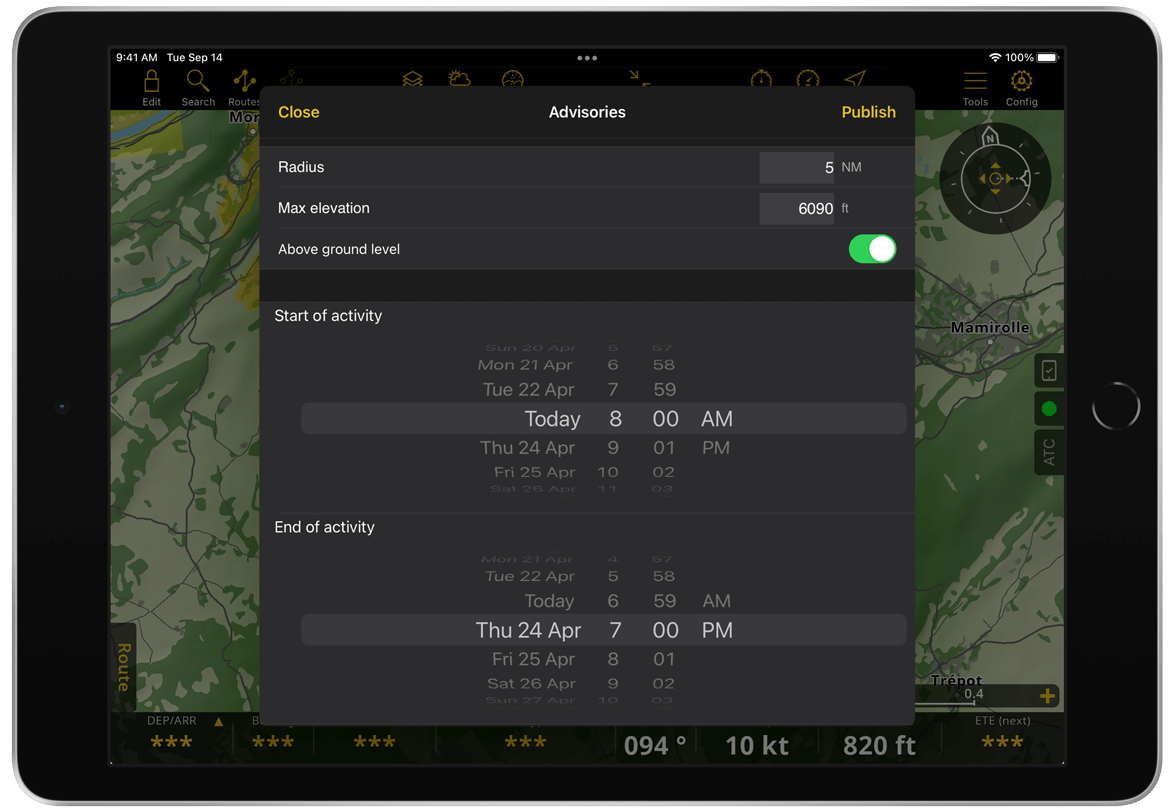
You need to have an Air Navigation account. See your Account in Configuration > Account.
Move the map to where you want to create an advisory.
Tap on a waypoint or press and hold on the desired location on the moving map.
From the waypoint popover, go to NOTAM tab.
Tap Publish Advisory activity.
Provide all necessary information on the Advisory window: Radius, Max elevation, Start and End of activity, Type of advisory, Number of aircraft and Message.
Tap Publish.
Edit Advisory activity#
You can only edit your own advisories.
Tap the advisory activity on the map.
Tap Edit on the popup window.
Edit the details you want to update.
Tap Publish.
Delete Advisory activity#
You can only delete your own advisories:
Tap the advisory activity on the map
Tap Delete
You can manage the display of advisories on the map in Map Options > Advisories.
Map Annotations#
You can add useful information to the Moving Map using map annotations. With this feature, you can highlight, draw geometrical shapes and write with a marker, customizing the color, line thickness and fill pattern. You can also assign attributes to annotations such as labels and remarks and define lower and upper altitudes, allowing you to create your own aeronautical data.
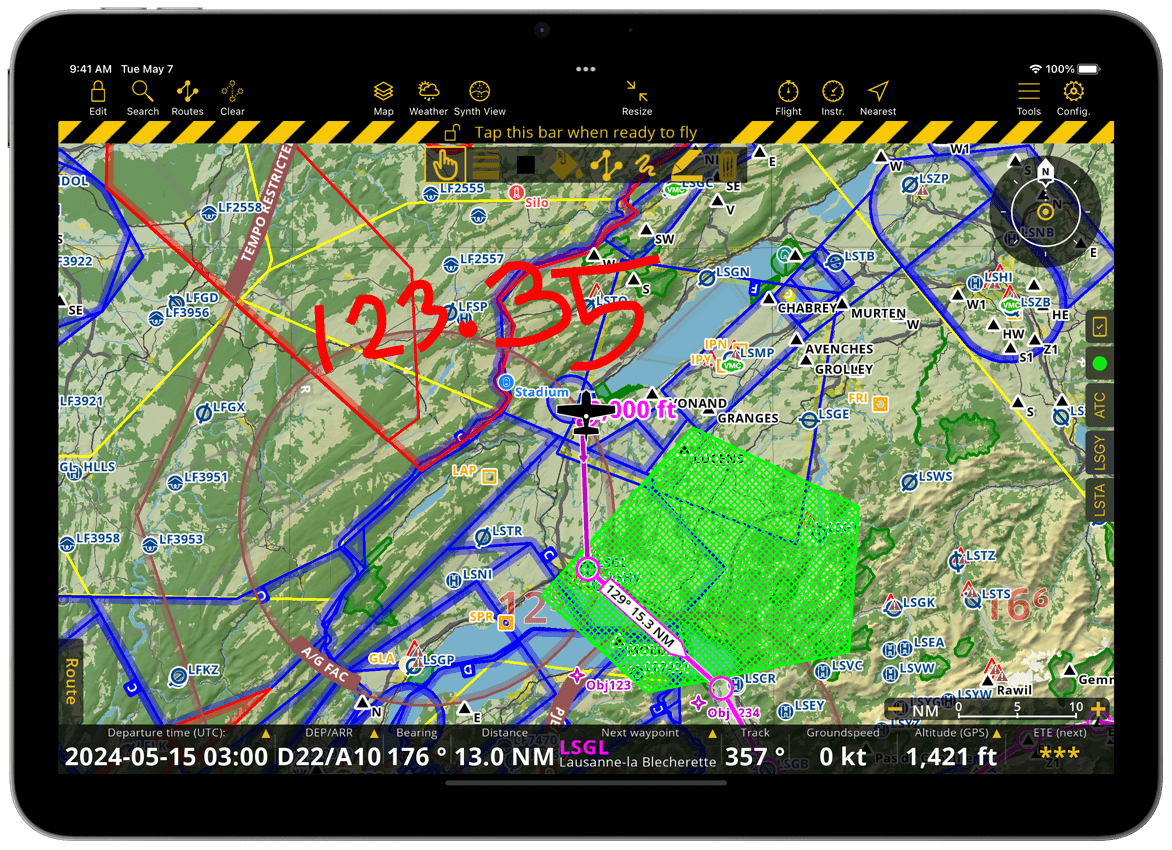
Activate map annotations by toggling ON the related option in Map Options > Guides. An additional toolbar will appear on the Moving Map below the yellow and black striped under-construction bar of the Edit Mode.
Annotation Toolbar#
The action buttons arranged from left to right are:
Select: Allows you to select, move, resize, change color and line thickness of existing annotations
Line: Allows you to choose the line/outline thickness for annotations supporting it
Color: Allows you to choose the outline and fill color for geometrical annotations
Note
Solid color fills will have some transparency to ensure you can still see the map below the annotation
Fill: Allows you to give geometric shapes a fill option: solid color, no fill or two pattern types
Shape: Allows you to create lines or geometric shapes by selecting an options: polyline, polygon, rectangle, circle and sector. Once the shape is selected, tap on the map to start creating it.
Free draw: Allows you to draw and write on the map with your finger
Highlighter: Allows you to highlight a map area with a bright color
Delete: Allows you to delete a selected annotation
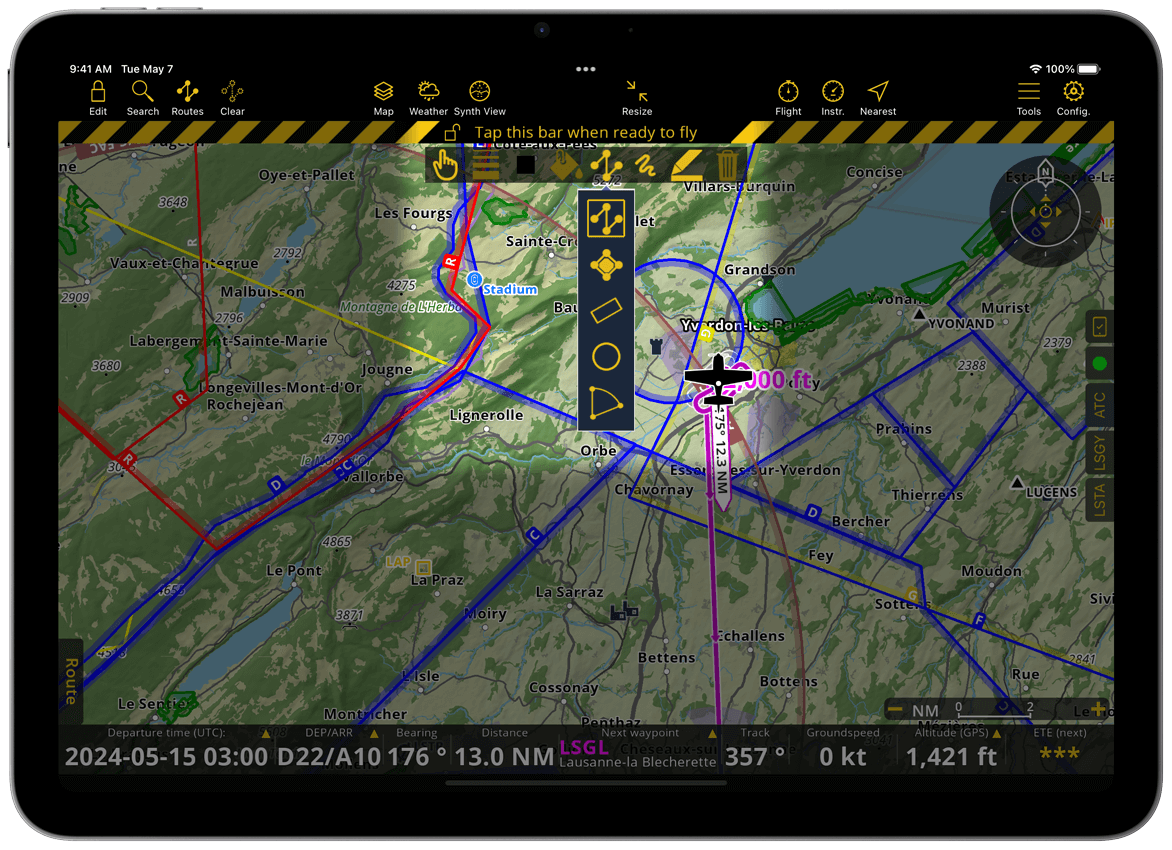
After creating an annotation, select it and tap on the black center icon to open the attributes window.
Annotations will remain displayed on the Moving Map until you delete them or disable the feature on Map Options > Guides. You can find the list of all your annotations on Tools > KML files & Map annotations. Tap on any annotation of the list to see it centered on the map. You can delete individual annotations by sliding it to the left or delete them all together using the ![]() icon in the top right corner.
icon in the top right corner.
You can also display map annotations on the Profile View.
Map Interactions#
You can interact with the moving map by using familiar touch gestures:
Tap a waypoint, airspace, weather station or NOTAM to reveal detailed information about it
Touch and drag to pan the map
Pinch with two fingers to zoom in/out
Touch with two fingers and rotate to rotate the map
Here is how the moving map with SmartChart looks with an Approach Chart on overlay, a planned route, airspaces and some NOTAMs
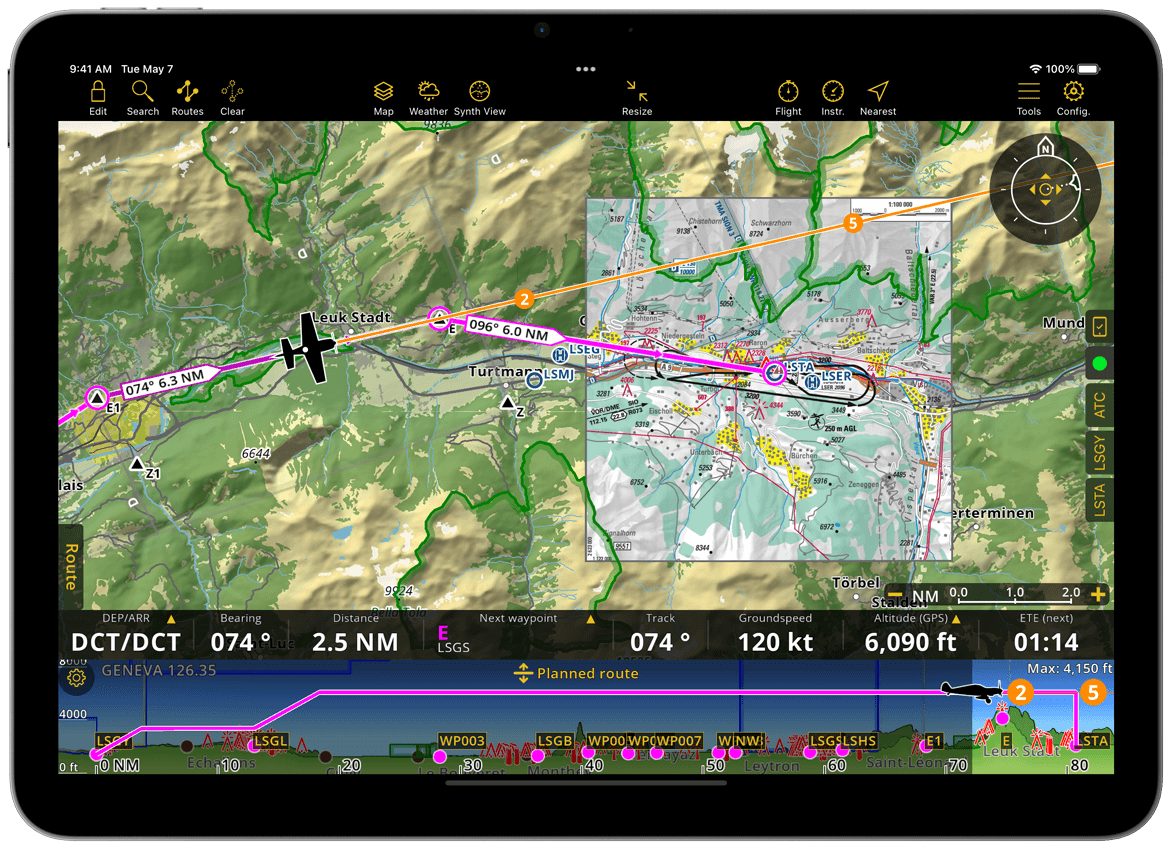
Scaled at 1.5 NM, here is how the moving map with SmartChart looks with an Approach Chart on overlay, a planned route, airspaces and some NOTAMs.
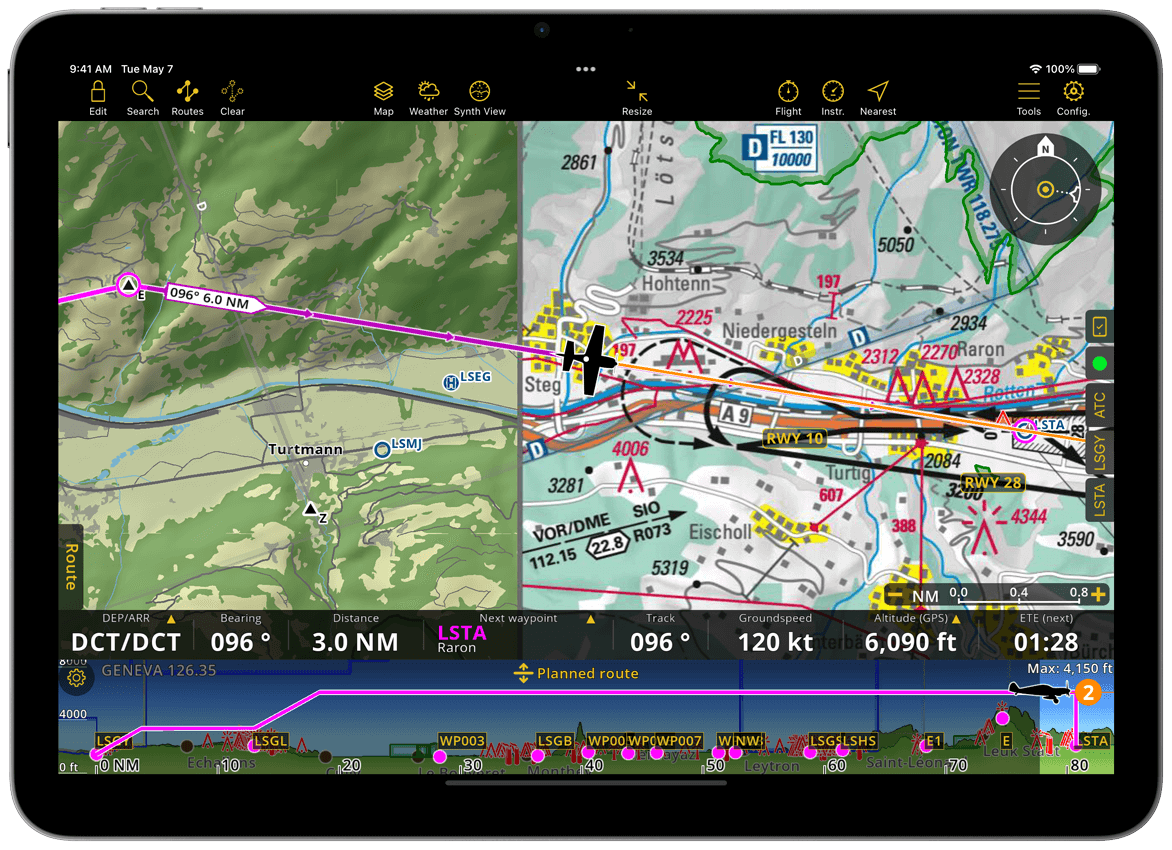
The same moving map with the Approach Chart overlay disabled.
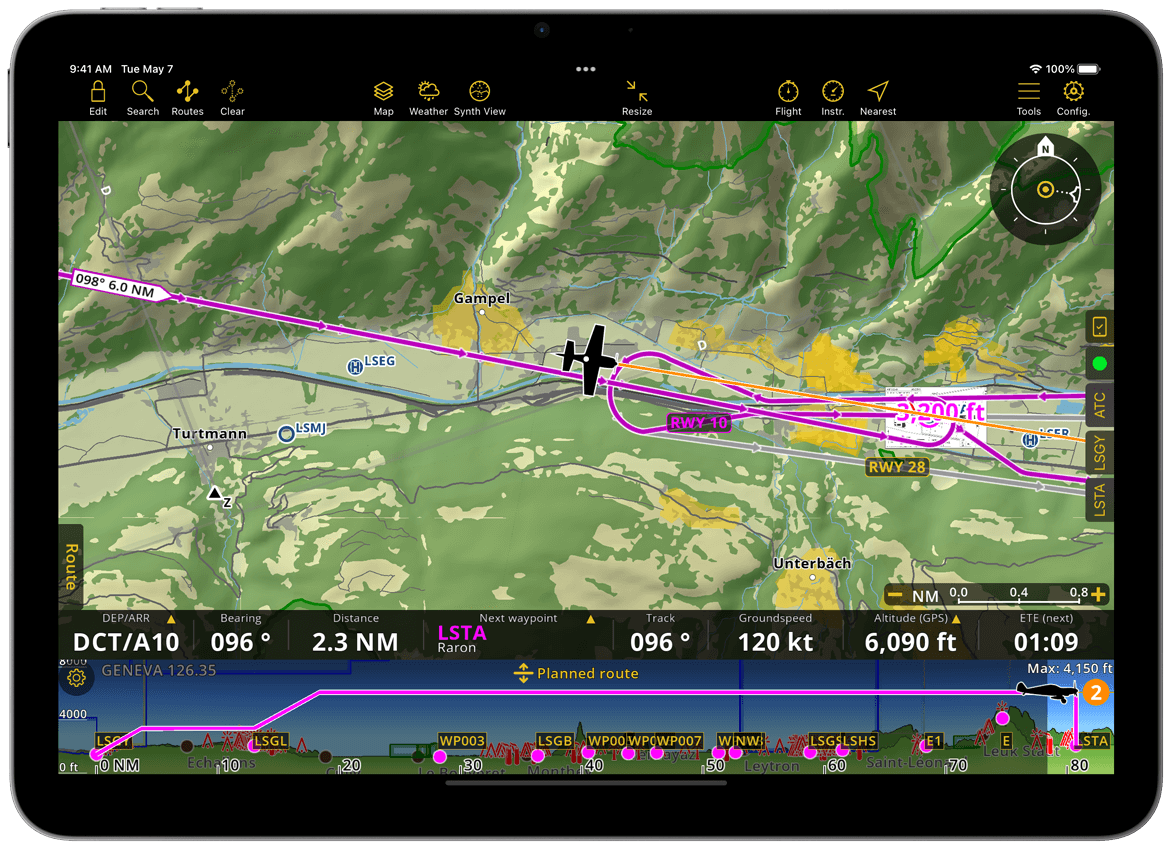
Map Widget#
Position indicator#
Your current position is indicated using an icon representing your current aircraft. In case the position is not precise enough, the icon is replaced by a circle centered on the last known position. After a few seconds, the circle is also removed.
Eye altitude#
At the bottom right, the map scale will show you the scope of the current zoom level.
The eye altitude provides you with the range of the displayed map. By default it is shown in NM, you can change this in Config > Settings > Distances & Speed.
Using two fingers you can zoom in/out on the map and the scale measure will change.
You can also use the - and + on the scale bar to zoom in/out.

Compass Rose#
North mode oriented#
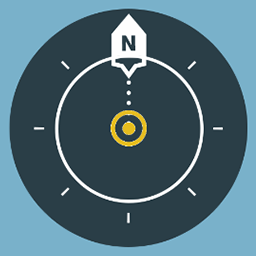
The map is oriented towards the north.
Track mode oriented#
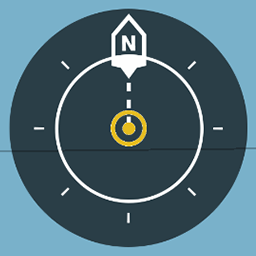
The map is oriented in the direction the aircraft is flying. This is based on the movement on the aircraft, so it won’t be accurate when not moving on the ground.
Panned mode oriented#

Moving the map will switch the compass to panned mode. In this case the map will be moved to the location of your choice, with the orientation of your choice. If your aircraft is outside of the screen, tap the compass once and the map will be centered to your GPS location. Long-pressing on the compass rose will lock the movement of the map.
Interactive Aircraft Position#
When the icon of the aircraft is outside of the screen, your aircraft is displayed in a bubble with distance from its location. Tap on it and the map will get centered on your current position.
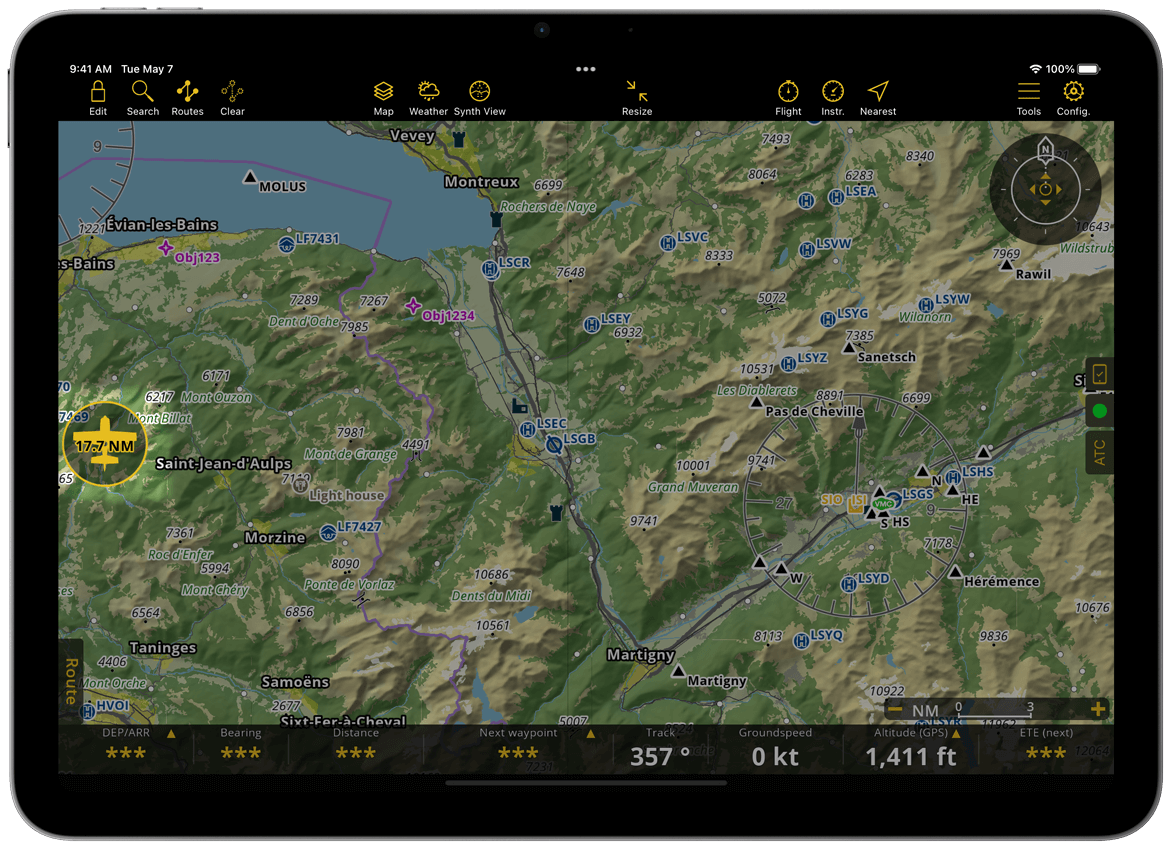
Example: The aircraft is outside of the map, on the left side
For more information about what can be done on the Moving Map, please refer to Map options menu.
Map Background#
SmartChart#
SmartChart is a worldwide vector map included in all subscriptions plans. The app generates the map in real time by leveraging topographic and aeronautical data.
The amount of data to represent the earth is huge and cannot be stored entirely on your device. As a result, SmartChart will select and download the most relevant data automatically for offline usage.
For safety reasons, the following data is always available on your device:
Aeronautical database of airspaces and waypoints (worldwide)
Country borders (worldwide)
Mora Grid (worldwide)
Any third-party chart, approach chart and map installed by the user
SmartChart will also automatically install and update terrain, satellite images, landmarks, etc.
around your position
around your current route
All downloaded data is saved within a specific storage limit.
Key benefits of SmartChart:
Guaranteed clarity with the adequate information at every zoom level
Additional information to the raster charts
Rotating shadows for clear distinction of valleys and mountains
Labels remain readable regardless of the chart’s orientation
Dark mode supported
Same design for all countries
Fine tuning
Works perfectly at extreme latitudes
Satellite view
Users can additionally download a specific area around a waypoint or route to make it available offline, find out more in Data downloads.
Easy to fly thanks to SmartChart#
Thanks to the data being downloaded dynamically, you can instantly view everything in your surroundings and start preparing for your flight.
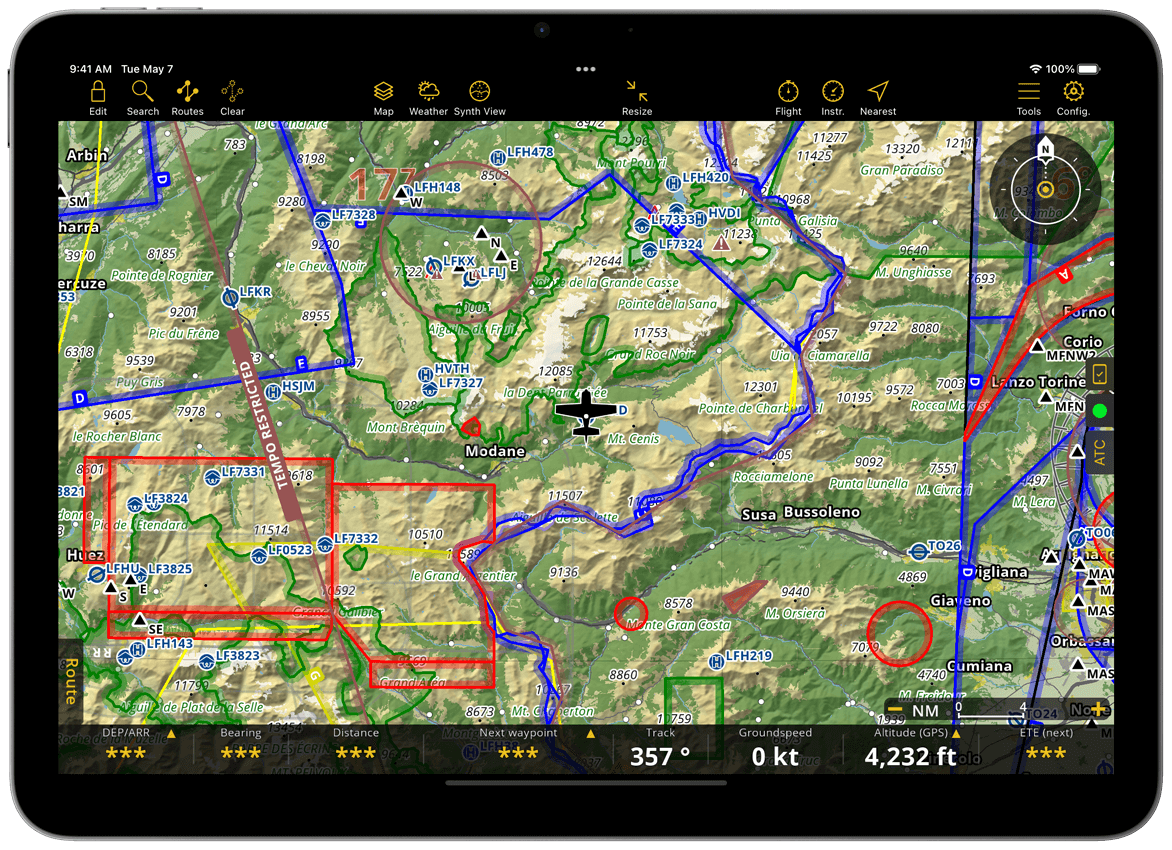
It’s possible to zoom out and see the whole globe, making it easier to jump to a different place.
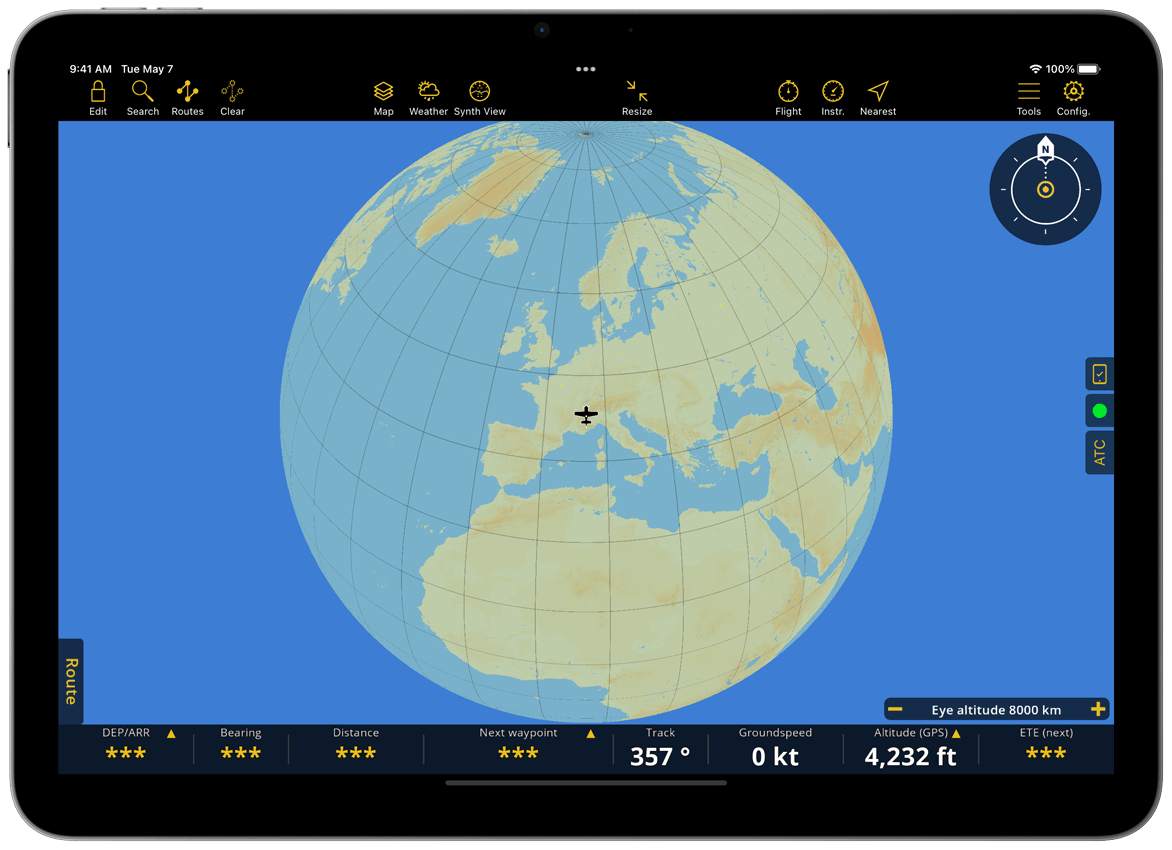
Mora Grid#
It shows on the map the safe altitude of the area to avoid any collisions with the ground and/or obstacles.
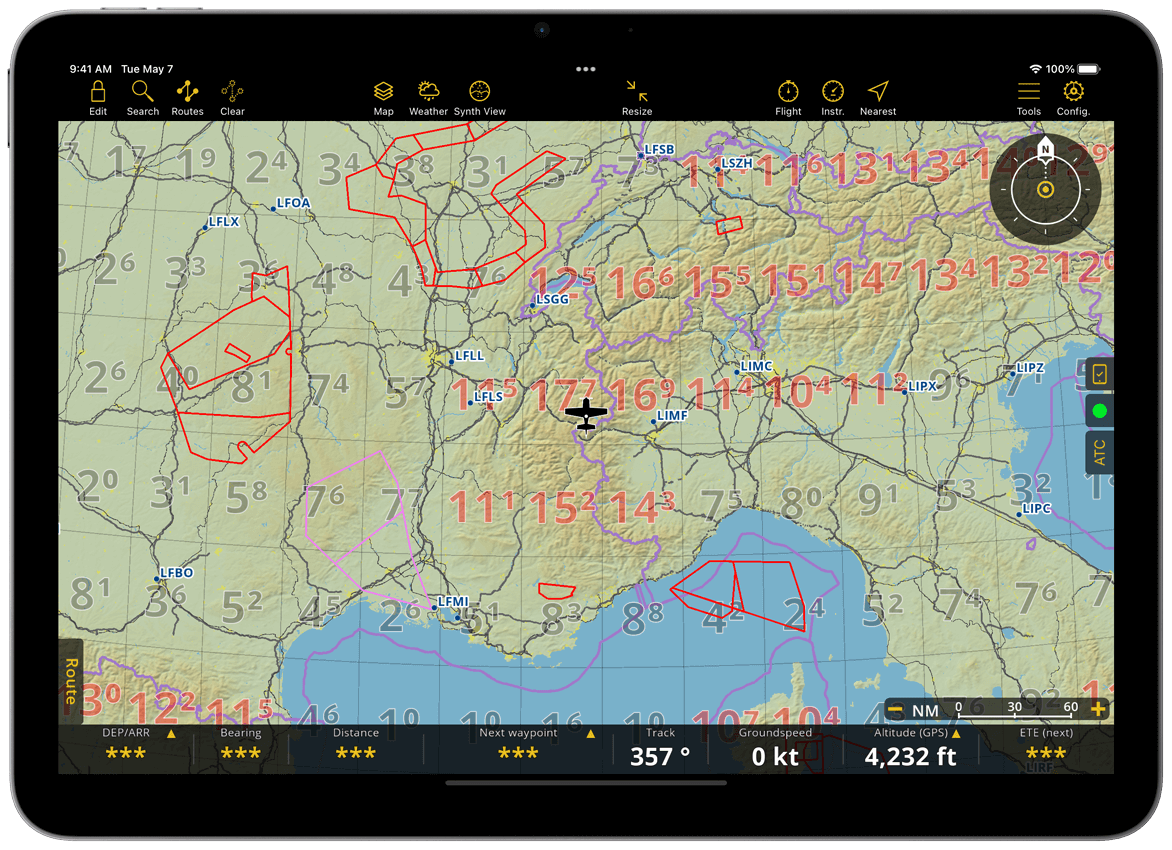
VOR Rosas#
VOR Rosas are centered on waypoints and shown as oriented to the North of the chart.
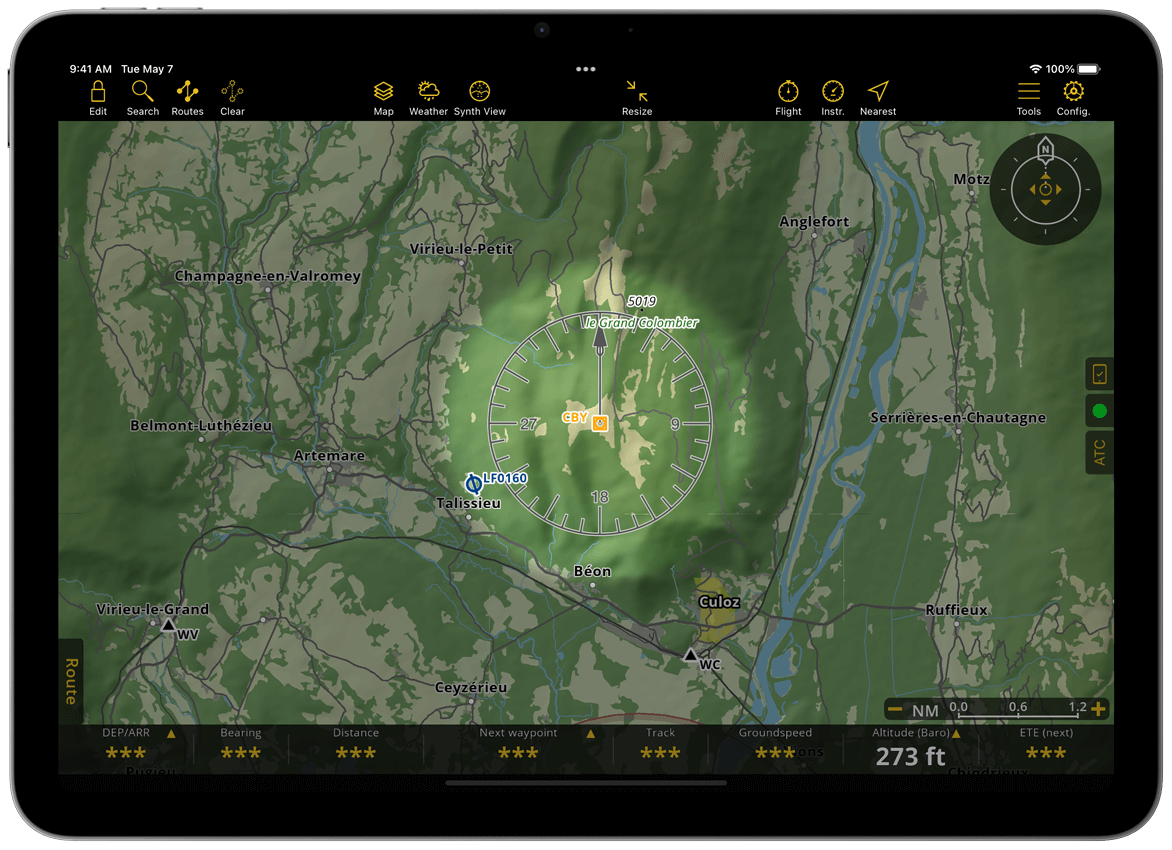
Toponyms#
Natural territories (mountains, rivers, lakes, etc.) and geographical entities (cities) of the country are shown on the map. Toponyms are displayed to help pilots have an easier navigation and awareness of their position.
Land covers#
The base terrain is colored according to land cover: forests, cities, swamps.
Third party charts#
Air Navigation Pro supports a wide variety of charts that can be displayed on the moving map. This feature is very helpful for users who are used to conventional maps but wish to navigate on them in a very less hassle way. The application provides reliable and accurate charts from third-party sources and can be acquired through the Store in the application or on our website. You can visit this page to check our partners that are providing these awesome charts.
Note
You can install one or more maps and display them all simultaneously. When maps overlap, they will be prioritized based on the order specified in Map Options > Maps. Additionally, you can import your own maps by following these easy steps in the User Maps section.
ICAO Chart#
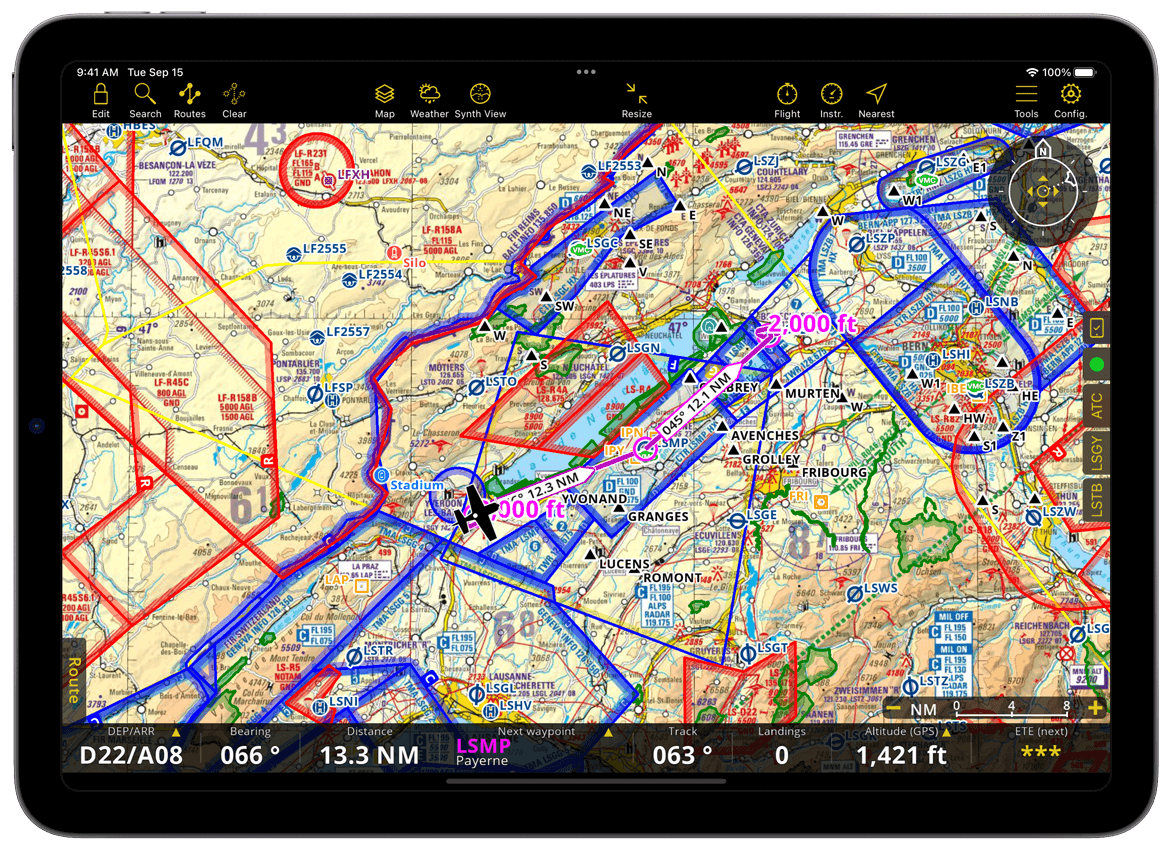
VFR Chart#
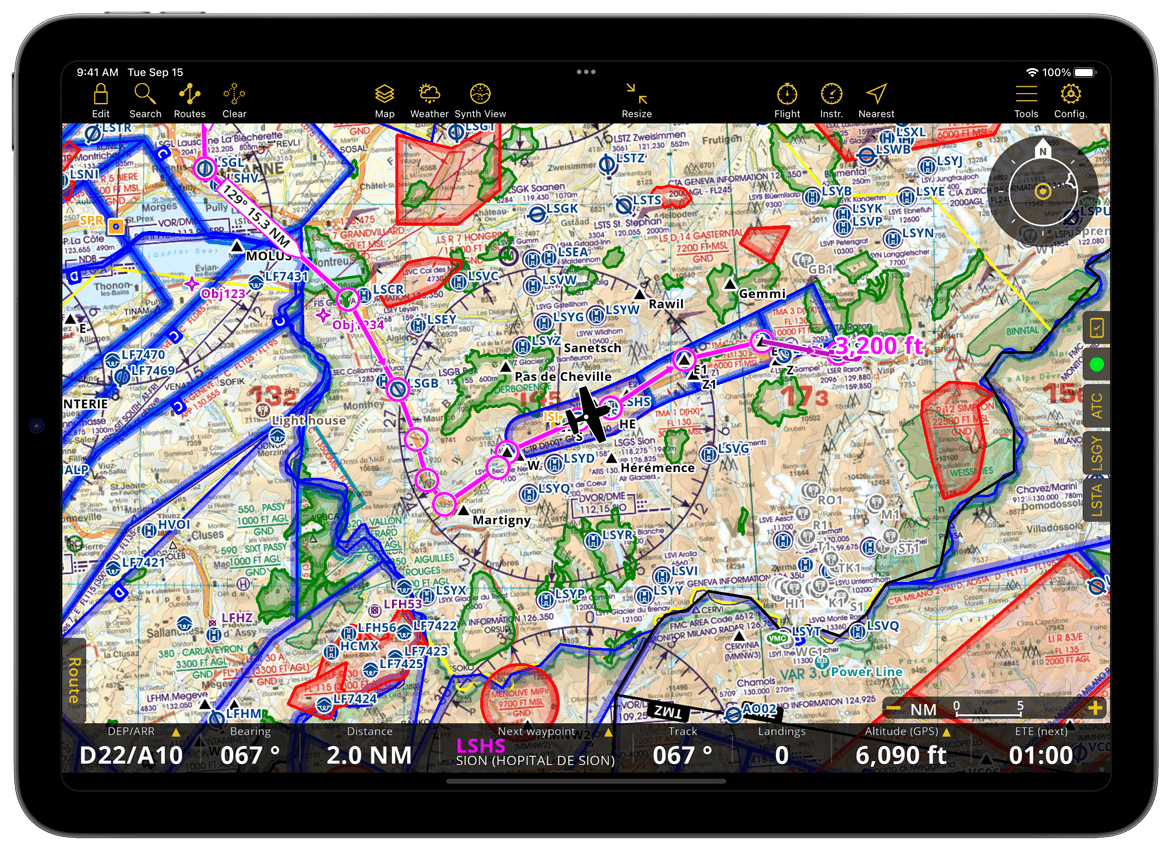
Alps VFR Chart#
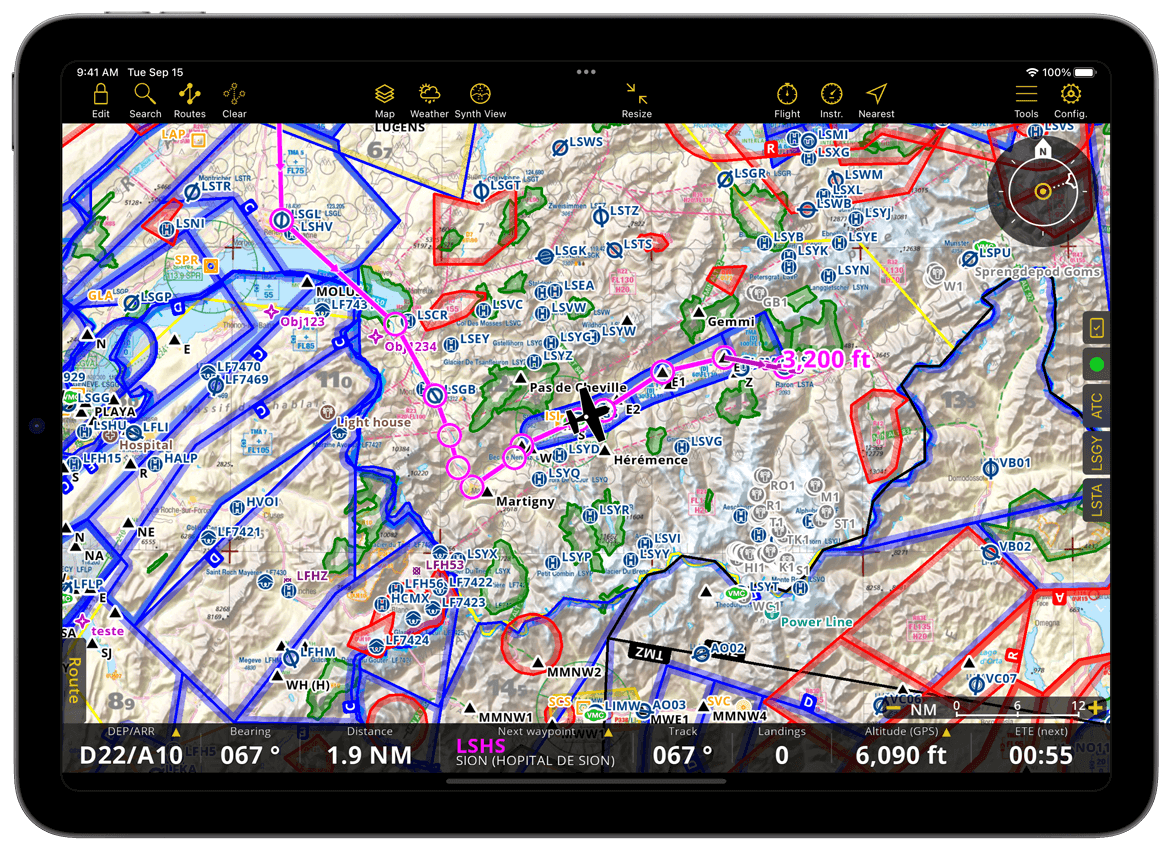
Topographic Chart#
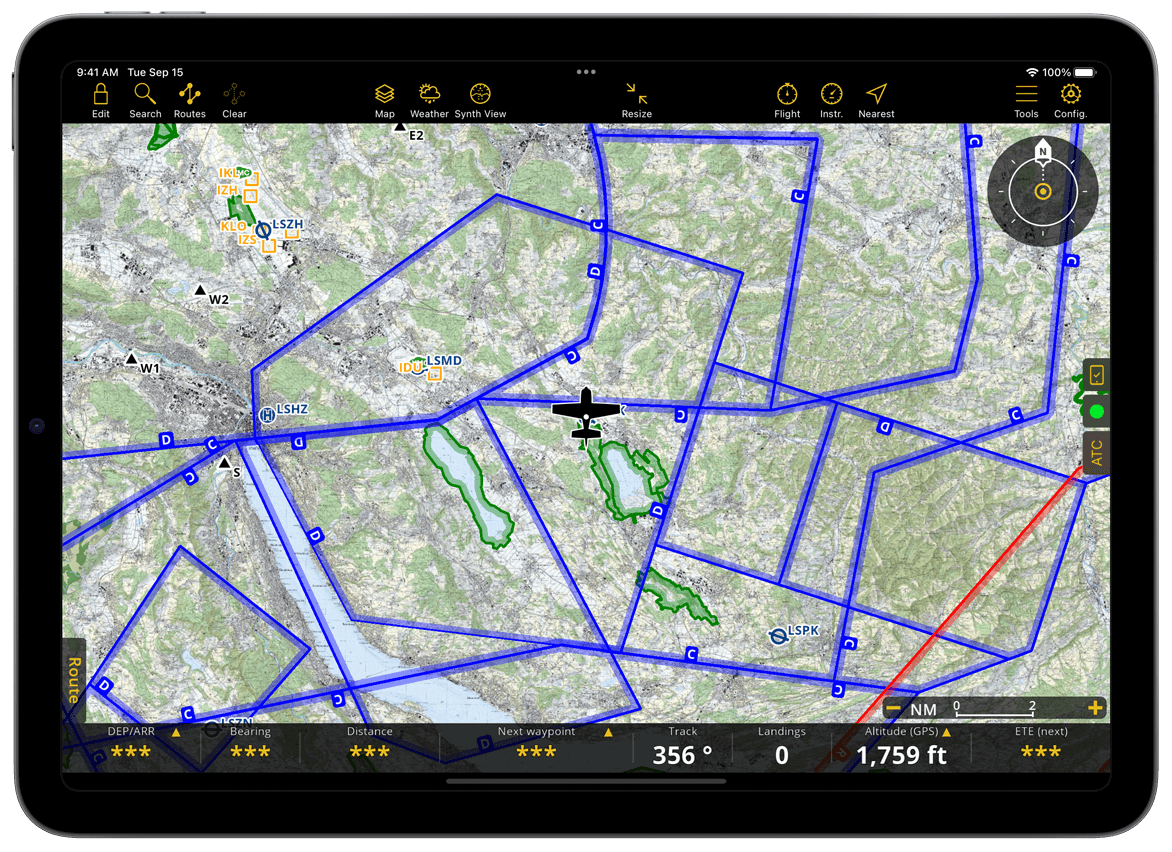
Glider Chart#
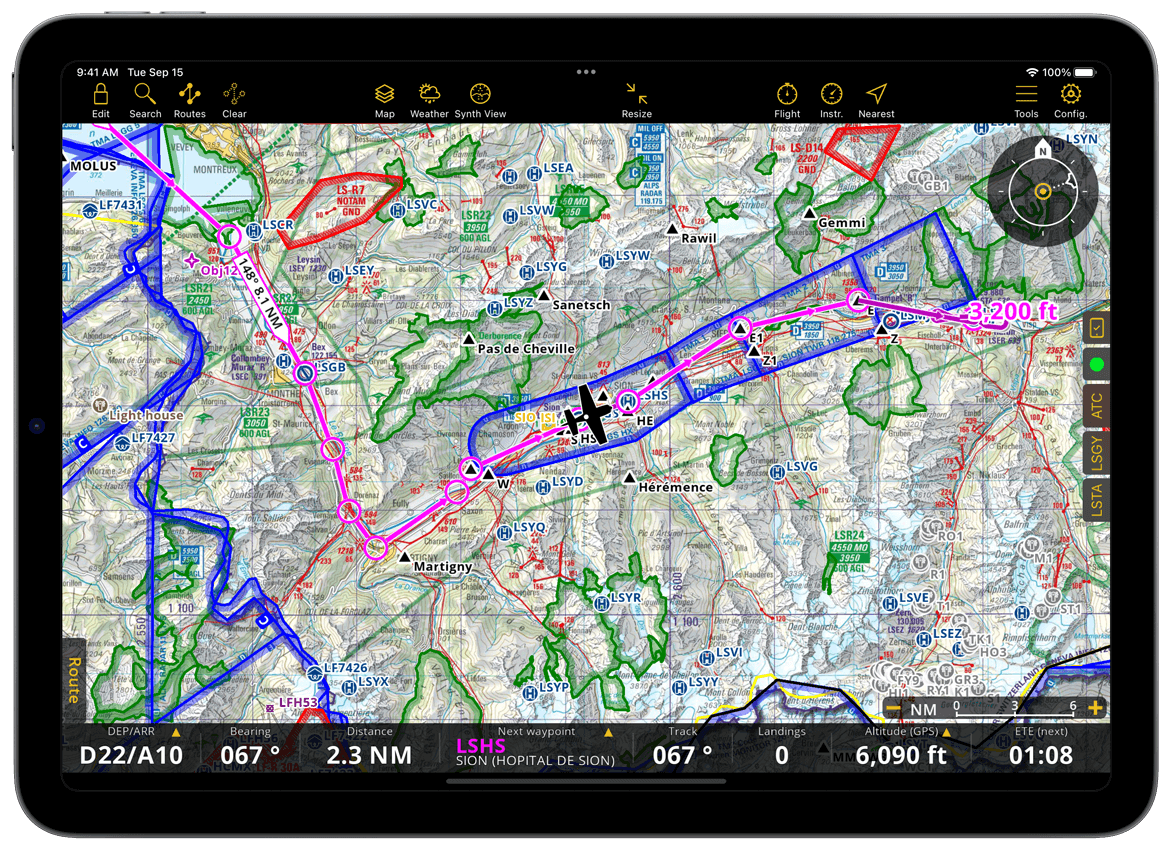
Helicopter topo Chart#
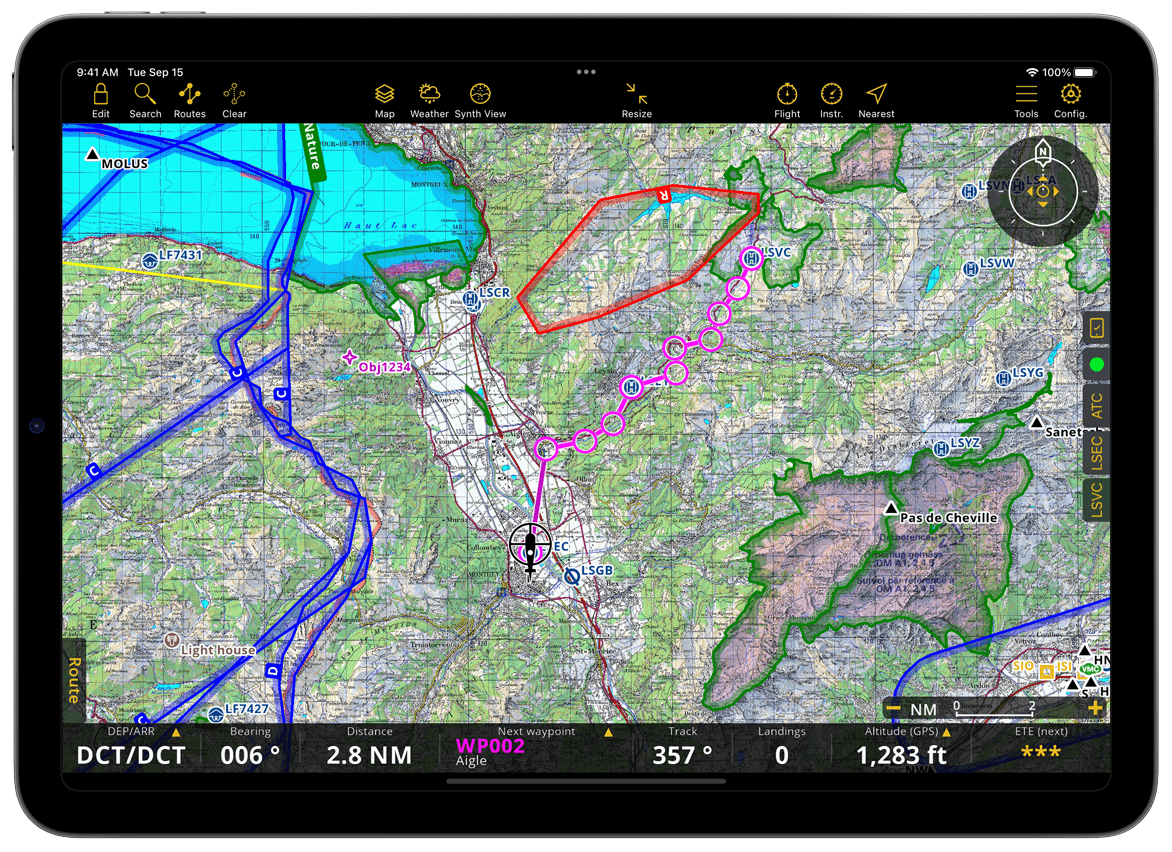
Approach charts#
Air Navigation Pro supports Visual Approach Charts and Instrument Approach Charts.
Countries that have approach charts#
The approach charts are going to be displayed on the map.
Here is the list of the countries that we have approach charts for:
Argentina |
Austria |
Baltic (EST,LVA,LTU) |
Benelux |
Brazil |
Chile |
Colombia |
Czech + Slovakia |
Danemark |
Finland |
France |
Germany |
Greece |
Israel |
Italy |
Norway |
New Zeland |
Russia |
Slovenia |
Spain |
Switzerland |
Uruguay |
USA |
South Africa |
You can purchases them here, by selecting one of the countries above.
You can install all available approach charts from a country or select the ones from specific waypoints and display the charts as you need them. This product can be acquired as individual products or from a subscription package.
Install approach chart#
Tap Config > Store.
Tap Restore - wait until the app loads all the products’ information.
Tap on the desired Georeferenced approach charts package.
Select which charts to install or tap on Install all.
Display them on the moving map#
Tap on an aerodrome in a country for which you have installed approach charts.
Go to ‘DOC’ tab
Example: LFBO Approach chart
Hide approach charts#
There are two ways to hide the approach chart displayed on the map.

